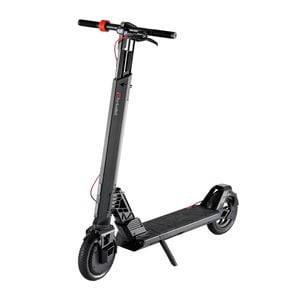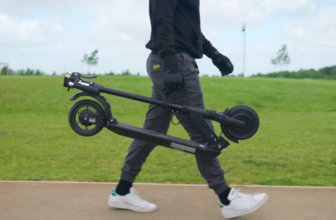Best 20 MPH Electric Scooters: 6 Selected From 15 Tested Models
Quick List: Best 20 MPH Electric Scooters
To find the 6 best electric scooters that can reach speeds of up to 20 mph, I shortlisted 15 models and tested them all across the criteria of top speed, acceleration, motor power, nominal and peak power, controller performance, handling, and braking.
Learn more about how I tested and selected the scooters.
See my 6 top picks below (ordered by Holiday Sale prices):
- Turboant X7 Max – $429.98
- GoTrax G4 – $449
- NIU KQi3 Pro – $559
- Turboant V8 – $569.98
- Horizon V2 (13Ah) – $749
- Apollo Air 2023 – $849
See all 15 of the shortlisted electric scooters that I tested in the photo carousel below.
See my top picks and reviews of each scooter
Best models by use case (e.g. for portability)
Compare design and performance specs
See how I tested and selected the scooters
Best 20 MPH Electric Scooters
Searching For the Best Model By Use Case?
See the best scooters by type (e.g. for heavy riders, portability, etc).
Cheapest
Further Information:
Best Cheap Electric Scooters
Heavy Riders
- Horizon – Supports riders up to 265 lbs
Further Information:
Heavy Duty Electric Scooters for Heavy Adults
Tall Riders
- Turboant X7 Max – Riders up to 6.4 ft
Further Information:
Electric Scooters For Tall Riders Up to 6ft 6″
Fastest
- Horizon – 23 mph
Further Information:
Fastest Electric Scooters
Longest Range
- Turboant V8 – 50 miles max (25 miles real-world)
Further Information:
Long Range Electric Scooters
Off-Roading
- None
Further Information:
Best Off-Road Electric Scooters for All Types of Terrain
Most Portable
- Horizon – 42 lbs, telescopic stem, and foldable handlebars
Further Information:
Best Foldable Electric Scooters (Portable, Compact & Small)
Commuting
Further Information:
Electric Scooters For Commuting
Hill Climbing
- Horizon – 15 degrees max, 9 degrees optimal
Further Information:
Electric Scooters For Climbing Hills: Breeze Up the Steepest of Inclines
Suspension
- Horizon – Front spring and dual rear shocks
Further Information:
Best Electric Scooters With Suspension
Waterproof
- Apollo Air – IP66 water-resistance rating
Further Information:
Waterproof Electric Scooters: Best Scooters For Riding in the Rain
Optional Seat
- Horizon – Detachable seat available for an extra $99
Further Information:
Best Seated Scooters
Biggest Wheels
- Apollo Air – 10 x 2.5 inches
Further Information:
Big Wheel Electric Scooters
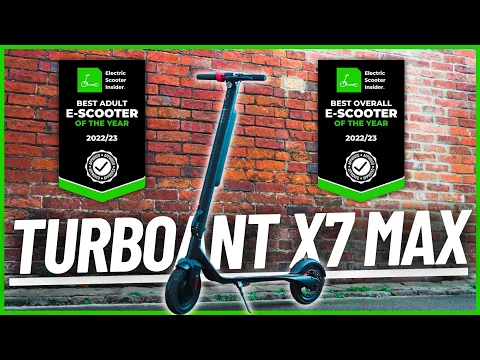
Performance Report:
Tester: Josh Frisby (190 lbs, 6.1 ft)
- Top Speed: 20 mph
- 0-15 mph: 6.9 s*
- Max Range: 32 miles
- Real Range: 18 miles*
- Braking: 3.0 meters*
- Max Incline: 15 degrees
- Optimal Incline: 9 degrees*
- Weight: 34 lbs
- Load: 275 lbs
Turboant X7 Max Overview:
Adding the word ‘Max’ to a scooter comes with a heap of pressure. Expectations are raised, so you better have the specs to back up the flex. Thankfully, Turboant is a brand that knows its way around a scooter, so the X7 Max was always going to deliver on its promise.
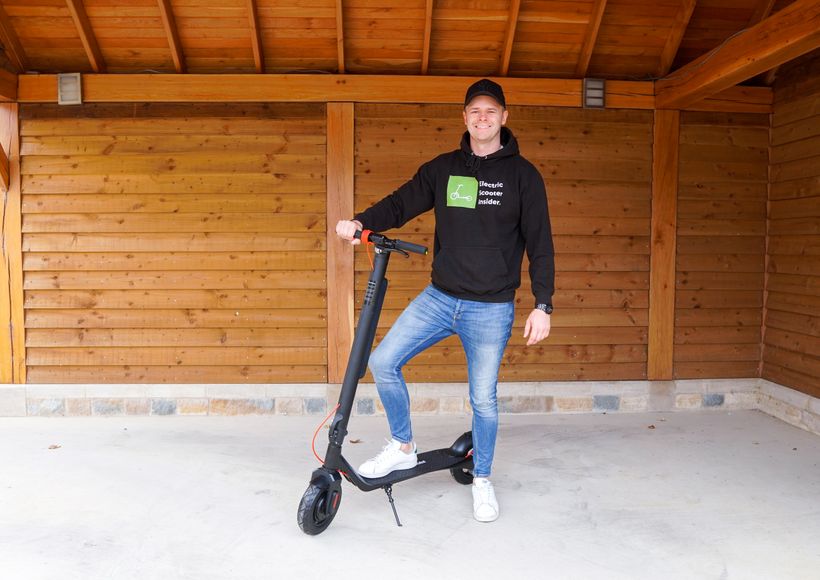
And when I say it delivers, it really does. I rate the Max so highly in fact that I awarded it the title of the Best Overall Electric Scooter in our 2022/23 awards, and this time around it won the 2023/24 award as the Best Scooter For Casual Riders. That’s quite the trophy cabinet for a model that costs under $500. It raises the bar set by the much loved X7 Pro in a multitude of ways, though its sizzling top speed of 20 mph remains triumphantly in place.
Packed with a plethora of features – including a detachable battery, upgraded folding mechanism, spacious frame, dual braking system, and an easy-to-read LED display – the X7 Max is a bona fide bargain.
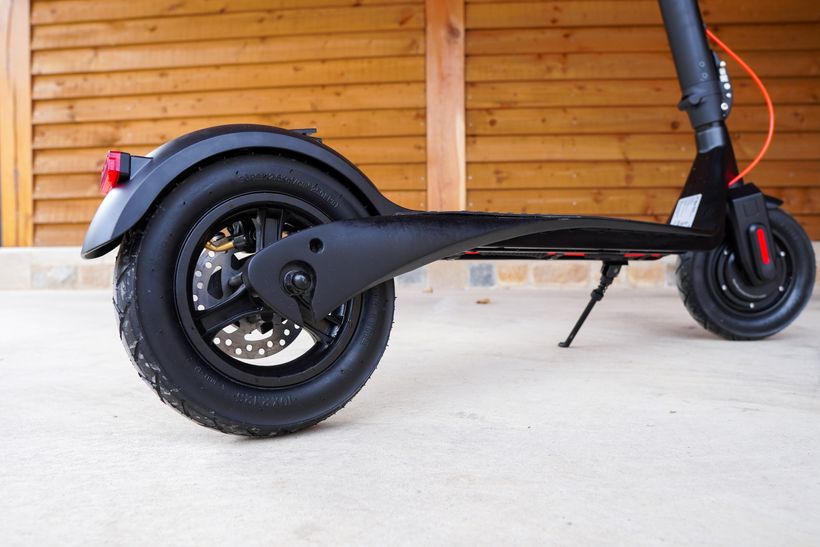
The Good:
- Extremely popular budget scooter
- Table-topping range in the sub $500 category
- Detachable battery means you can extend your range indefinitely with the purchase of spares
- Reliable dual-braking system
- Plush 10-inch tires
- Intuitive folding mechanism
- Well suited to both tall and heavy riders
- Sleek, sweeping frame
- Ergonomic controls
- IPX4 water-resistance rating
The Bad:
- Additional lighting is needed for night rides
- The thick stem can be cumbersome to carry for small hands
Why I Recommend the Turboant X7 Max:
The Turboant X7 Max is an upgrade of the hugely popular X7 Pro, so it had a strong base to build from. You get the same reliable ride and 20 mph top speed, but now it comes with a whole lot more. By carefully listening to customer feedback, the brand has taken what was already a great scooter and ramped everything up a notch.
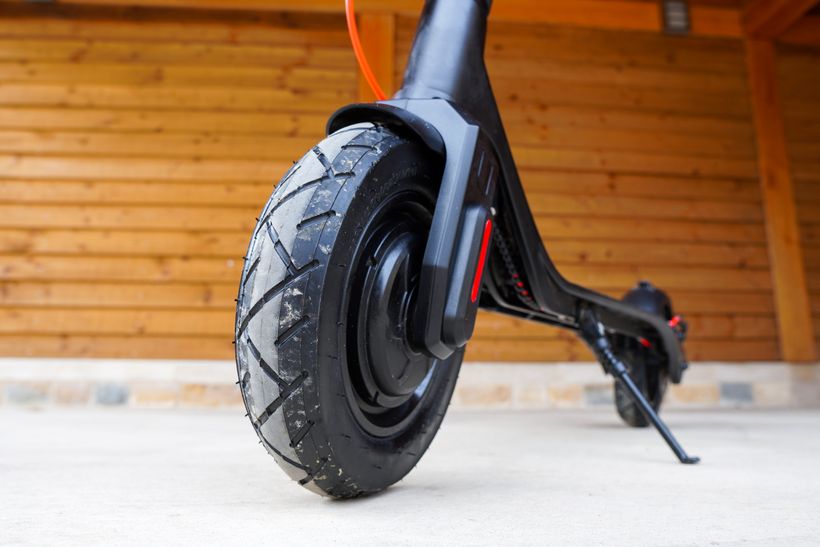
Let’s first look at its pace. While the 36V 350W motor is capable of the same 20 mph top speed as its predecessor, the Max can get there marginally quicker. Its acceleration rate of 0-15 mph in 6.9 seconds means it’s 5% faster than the X7 Pro, and a whole 1.1 seconds quicker off the mark than the pricier GoTrax GMAX Ultra.
Being an excellent entry-level scooter, the X7 Max is designed with safety in mind. Its dual braking system includes a front electronic brake and a rear disc. This is particularly effective because braking power is applied to both wheels simultaneously. Additional improvements in the brake pad calibration mean that, from 15 mph, you’ll come to a complete stop in a laudable 3.0 meters (a big improvement over its predecessor's 5.0 meters). It’s also worth noting that there’s no longer the tire-destroying fender stomp brake, while the brake cables have been tidied up, delivering a much more reliable braking system.
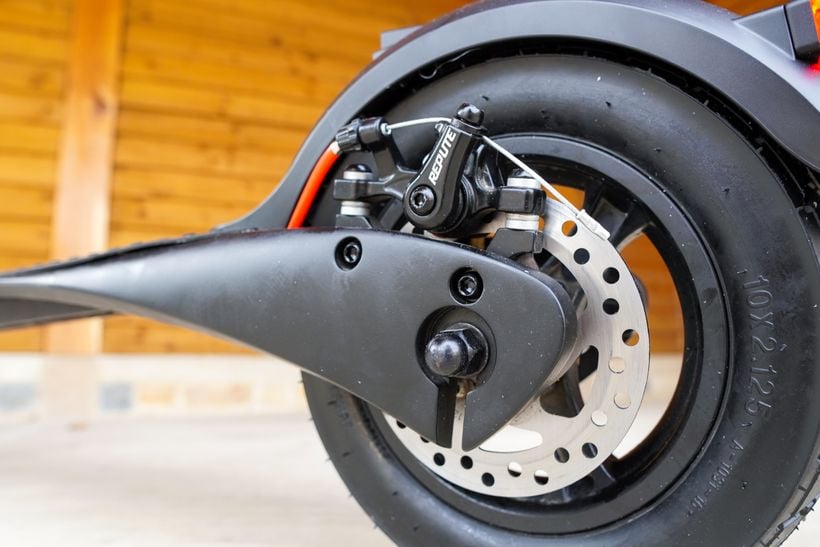
You’re not going to get a suspension system on a scooter in this price category, but that doesn’t mean that the Turboant X7 Max is uncomfortable to ride. Its expansive handlebars, spacious deck, and 10-inch air-filled tires work in sweet, sweet harmony to ensure a smooth, balanced, and controlled ride. You’ll notice the lack of springs if you stray off the beaten track, but if used for its correct purpose (i.e. riding in urban environments), then the X7 Max is a delight to ride.
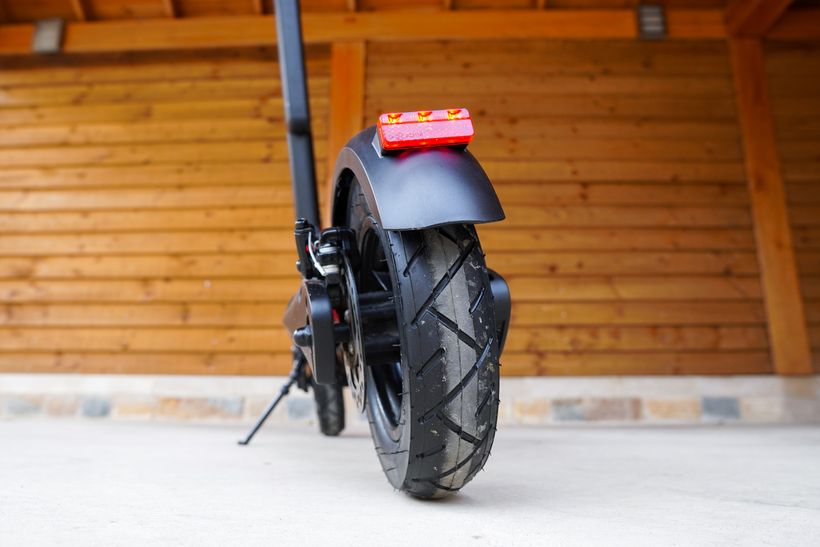
The part of the scooter that you’ll likely be paying the most attention to as you ride will be the display. With the X7 Max, you get the same centrally-mounted LED screen built into the top of the stem as found on the X7 Pro. However, the interface has been updated to make the digits larger and easier to read at a single glance. Also on the handlebars, you’ll find the all-in-one ergonomic thumb throttle that can be used to easily modulate your speed, switch riding modes, and turn the lights on or off.
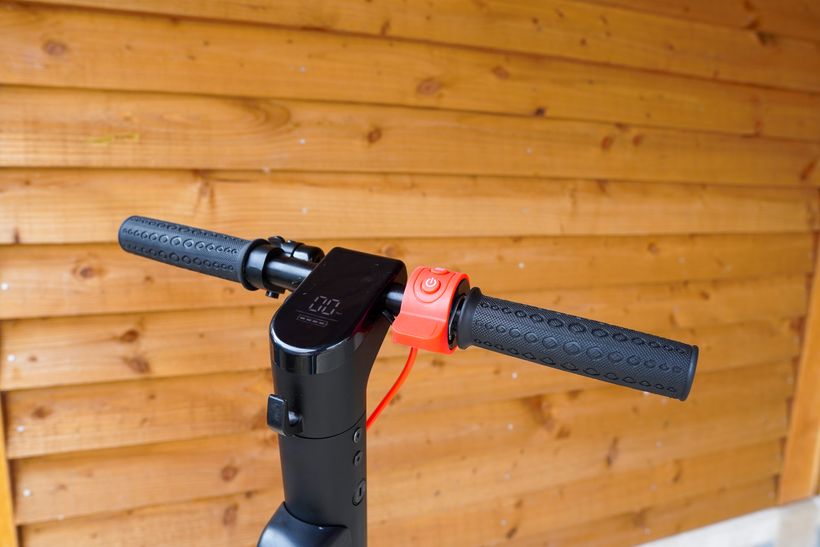
As you may be able to guess from the name ‘Max’, one of its key upgrades is the larger frame. The stem is 2.5 inches taller, the deck is longer and wider, and the newly tapered chassis allows for an extra inch of ground clearance.
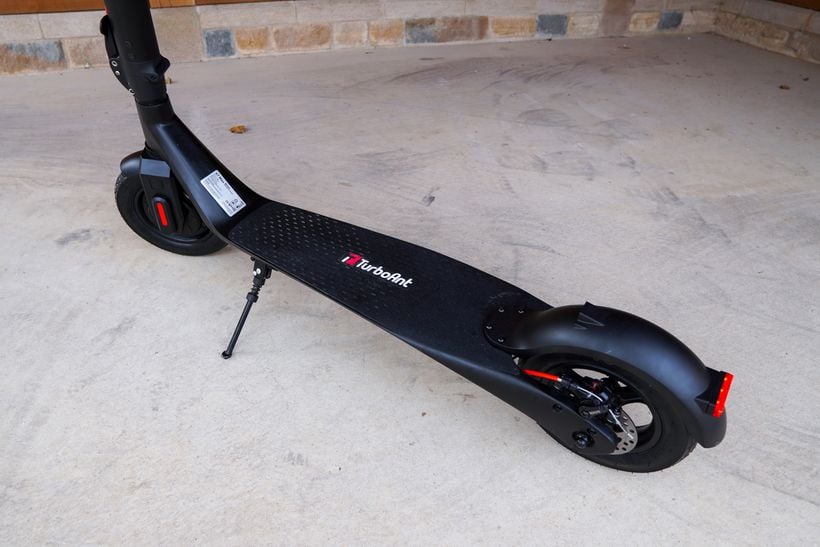
Paying special attention to the stem, it’s home to this scooter’s crowning glory – its detachable 10Ah battery. Unlike the X7 Pro, the one on the Max comes with a lock for added security. Detachable batteries are as rare as a dry day in Seattle, so to have one on a budget model is a steal.
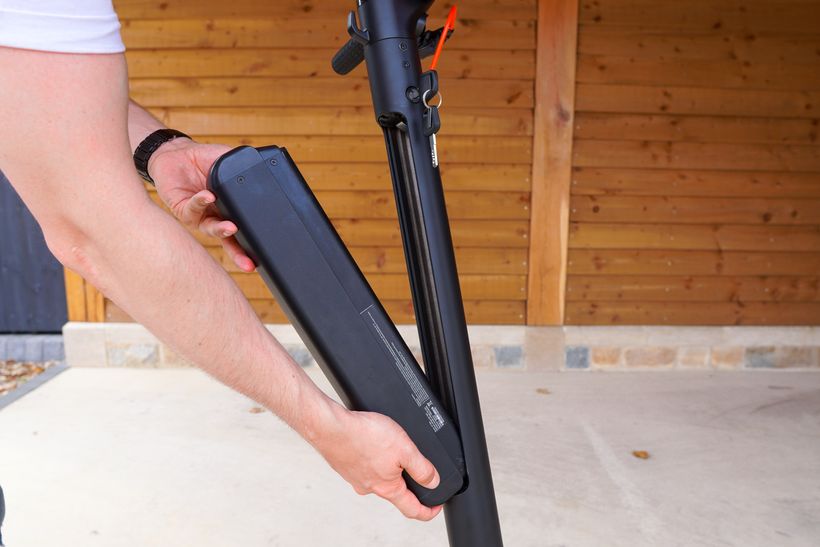
There are a host of benefits that the removable battery brings to the table. Firstly, it makes charging easy; instead of taking the whole scooter to a power outlet, you only have to take the battery. Secondly, you can remove the battery from your scooter so thieves can’t pinch it. And perhaps most importantly of all, a removable battery means that you can extend your maximum range from 32 to 64 miles with the purchase of a spare (or, 18-36 miles if you ride in the fastest setting).
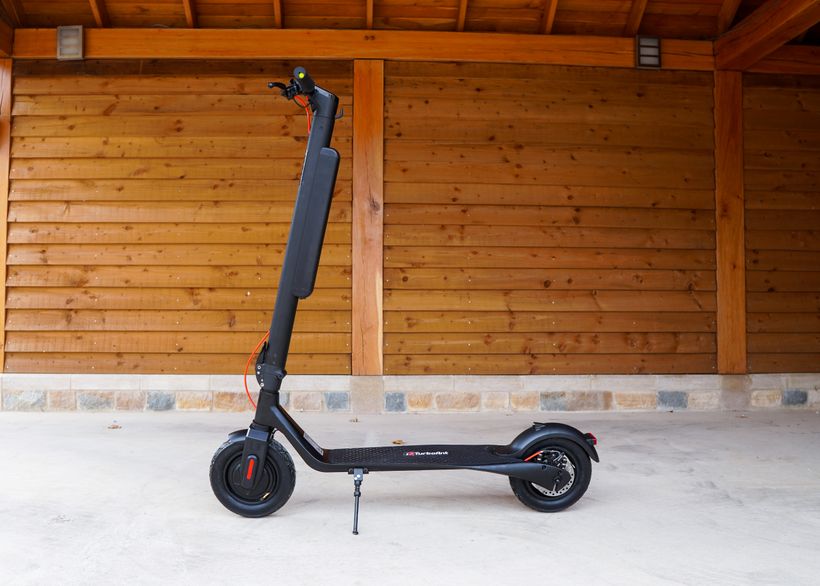
Despite being larger and heavier than the previous model, the X7 Max still only weighs 34 lbs. It can easily be picked up in one hand, carried onto a bus, or placed in the trunk of your car. It’s also simpler to fold thanks to its superior folding mechanism. If you work in the city and you’re looking for an affordable, greener means of commuting, then the X7 Max will be a great fit.

With so many fine-tunings and upgrades, the Turboant X7 Max is a 20 mph scooter that offers exceptional value for money. It looks great, is smooth to ride, and promises to raise a smile on the face of anyone who is looking for a reliable, spirited scooter that costs less than $500.
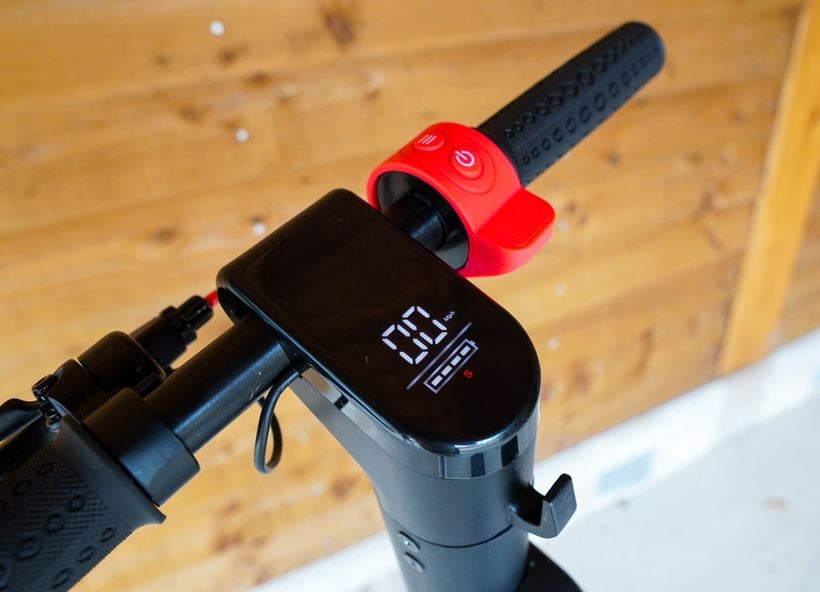

Performance Report:
Tester: Josh Frisby (190 lbs, 6.1 ft)
- Top Speed: 20 mph
- 0-15 mph: 6.3 s*
- Max Range: 25 miles
- Real Range: 14 miles*
- Braking: 6.0 meters*
- Max Incline: 15 degrees
- Optimal Incline: 9 degrees*
- Weight: 36 lbs
- Load: 220 lbs
GoTrax G4 Overview:
GoTrax is a brand known for playing the safe card. Its scooters are well-built, durable, and balanced – they also typically come with the roar of a kitten. The G4 is an interesting diversion away from this successful formula: it packs a bit of a punch.
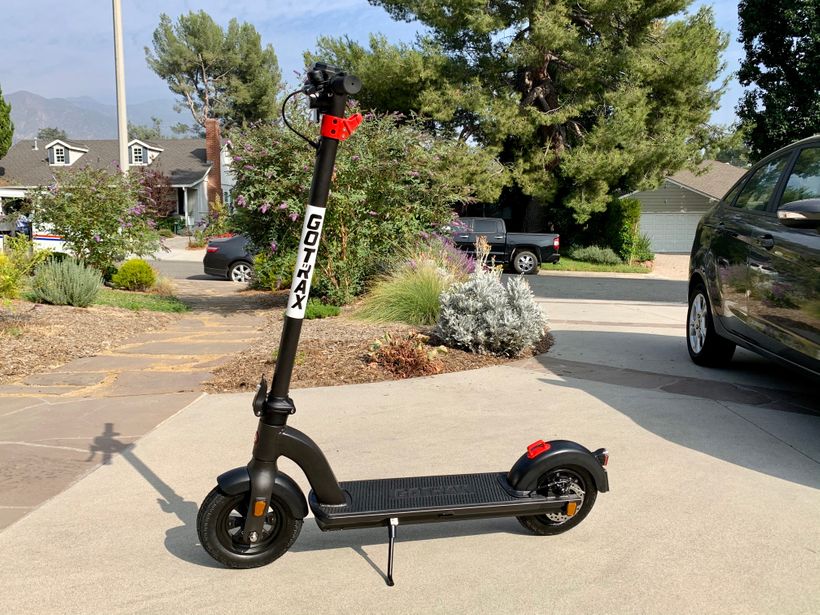
Yes, it’s still a relatively gentle scooter, and yes, it’s great for riders new to the game; yet, with a plucky top speed of 20 mph, it’s also a tempting option for those who want to raise the stakes.
Feature-rich, reliably robust, and good on the eyes, the GoTrax G4 is a forward-thinking scooter that, though arguably less impressive than similar, lower-priced models, nevertheless delivers decent value.
The Good:
- Durable build quality
- Easy-to-use one-click folding mechanism
- Intuitive controls
- 10-inch shock-absorbing, air-filled tires with a rounded profile
- Front headlight and rear taillight
- Built-in digital lock and cable lock
- Great handling
- IPX4 water-resistance rating
The Bad:
- The battery readout isn’t accurate
- Poor braking performance
Why I Recommend the GoTrax G4:
Counting the likes of Turboant among your competition is a tough gig for a scooter brand. But with the G4, GoTrax is holding its own. A budget-friendly electric scooter with the speed and stamina to transform everyday A to B journeys into enjoyable jaunts is a description usually reserved for scooters like the Turbaont X7 Max, but it’s also wholly applicable here.
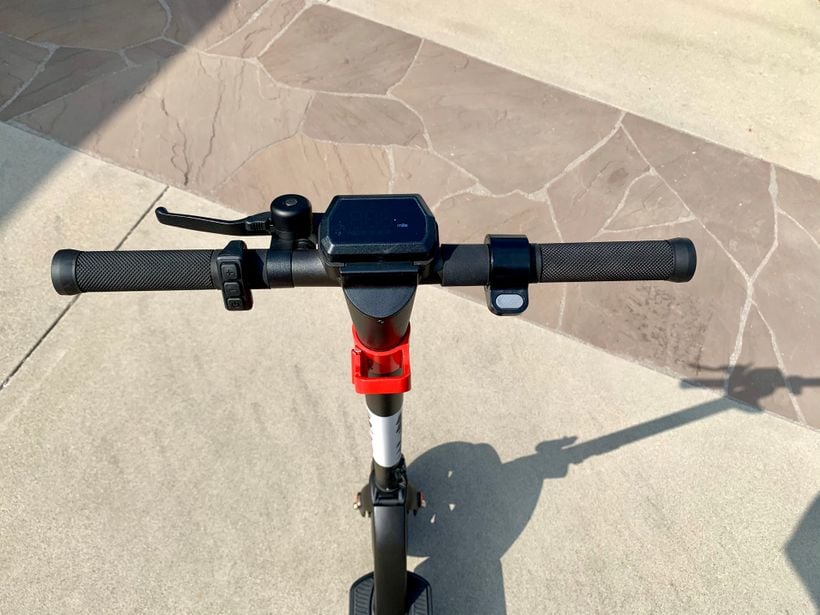
The G4’s 350W motor isn’t going to leave your mouth as dry as a desert, but 20 mph isn’t exactly conducive to an oasis of calm, either. It's zippy in every sense of the word, easily eclipsing the average 15.5 mph top speed of Gotrax’s other budget models.
There is a caveat, however: the G4 is a kickstarter scooter, meaning its acceleration rate will potentially leave you feeling a little underwhelmed as you push off – expect a full 12 seconds to elapse before you reach top speed. But hey, look on the bright side: if you’re seeking a scooter to use on a busy urban commute, the slower acceleration curve is unlikely to prove to be a disadvantage. It’s got enough speed to be competitive in a cycle lane, while the gradual increase grants you extra control when holding down the throttle on bustling streets.
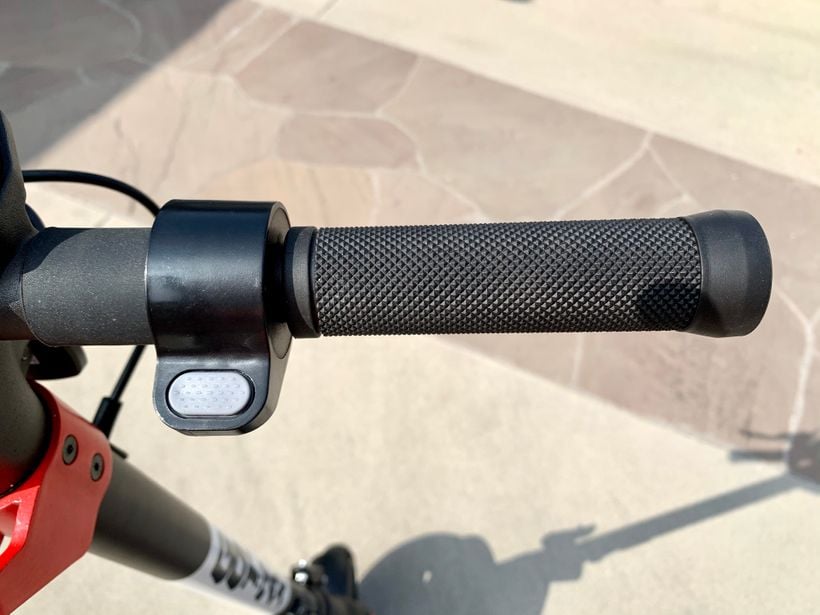
Besides, the G4 has a lot more to shout about than speed alone. Like the scooters featured before it on this list, you get a large pair of plush pneumatic tires. The air that fills them provides a satisfying cushion to absorb most of the shocks that you’re likely to experience in built-up urban areas. I also found that the low center of gravity afforded by the deck-mounted battery added a feeling of stability when carving from side to side and gliding around corners.
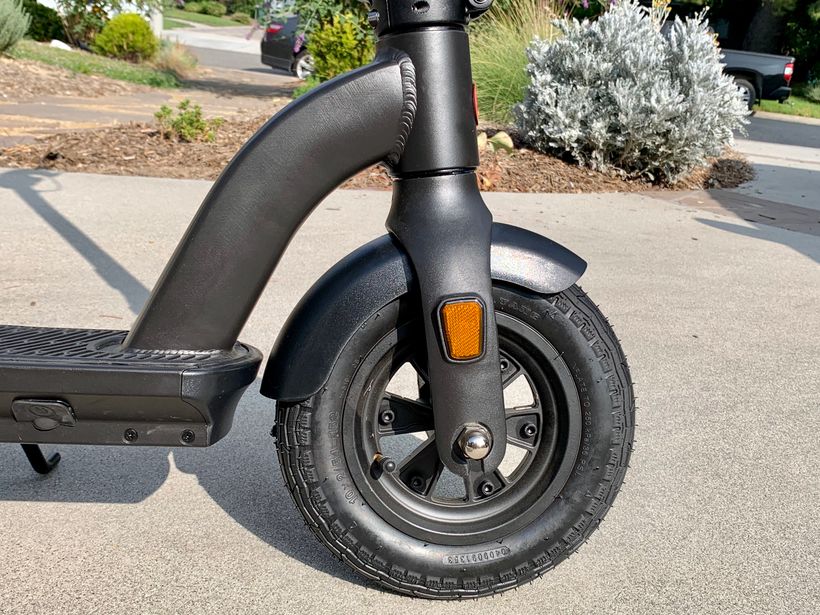
Unfortunately, this sense of control doesn't seep through to the brakes. While the G4 pairs an electromagnetic braking system with a mechanical disc, it takes 6.0 meters to stop from 15 mph. This is double the distance that it takes its rival, the Turboant X7 Max.
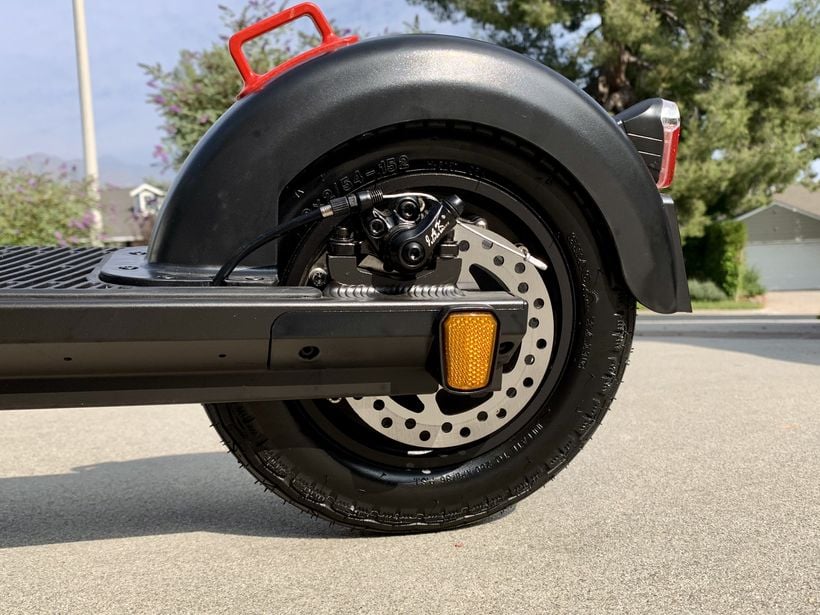
As well as the brake lever, the handlebars feature a bell, thumb throttle, display, and control pad. The display is large, easy to read, and shows all the necessary information such as speed, battery life, and distance. From the cockpit, you can also activate the cruise control, digital lock, and headlight (which could do with some support from an extra clip-on light).
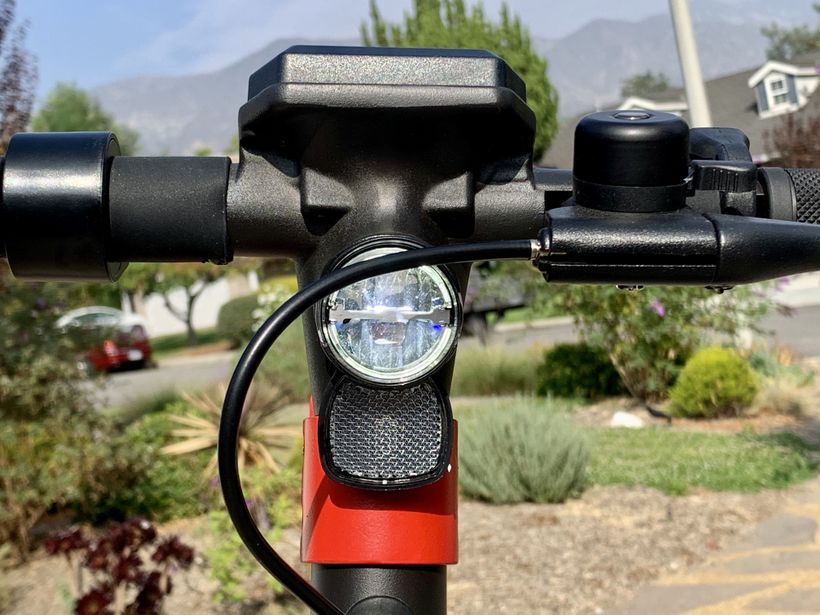
With this being a GoTrax scooter, you can be also assured of its build quality. The sturdy frame is made from an aerospace-grade A6061 aluminum alloy, while all the cables are tucked neatly away to provide a professional finish. Elsewhere, the roomy deck grants lots of space for both feet and has a deeply treaded rubber surface for extra grip.
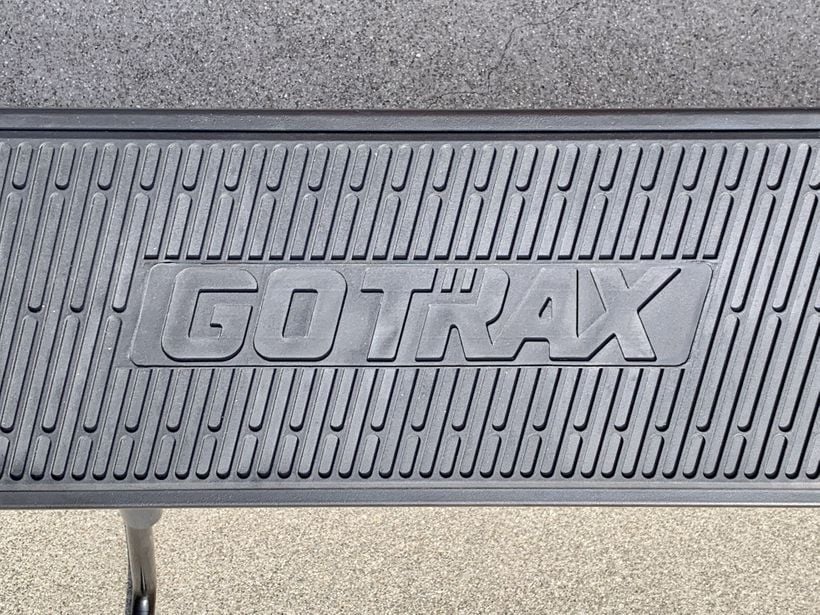
And despite its solid appearance, the G4 only weighs 36 lbs, which is an ideal weight if you’re looking for a portable scooter. The simple one-click folding mechanism collapses it into a compact package, while a catch protruding from the rear fender holds the folded stem securely in place.
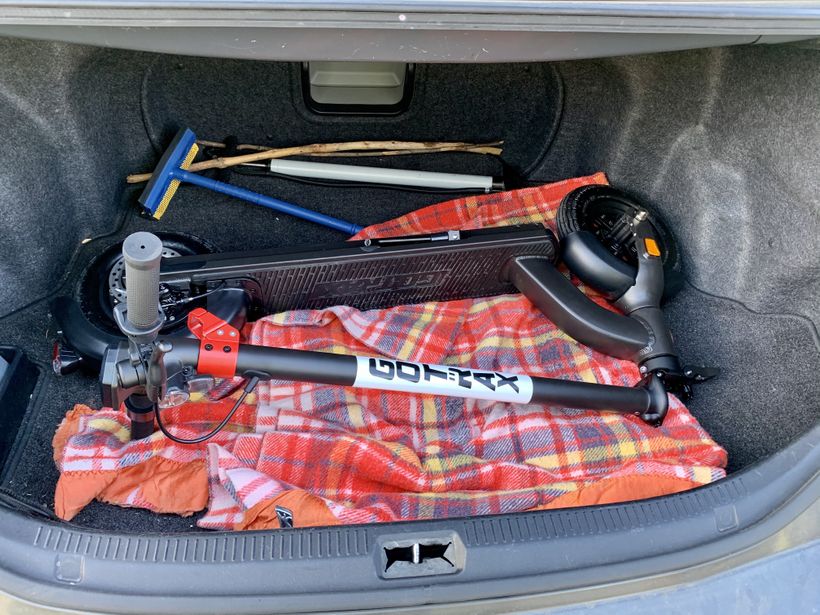
Although the G4 didn't quite wow me in the way that other budget scooters have, it’s still affordable, reliable, and satisfyingly quick. The inclusion of features like the IPX4 water-resistance rating and cable lock also means you get good bang for your buck.
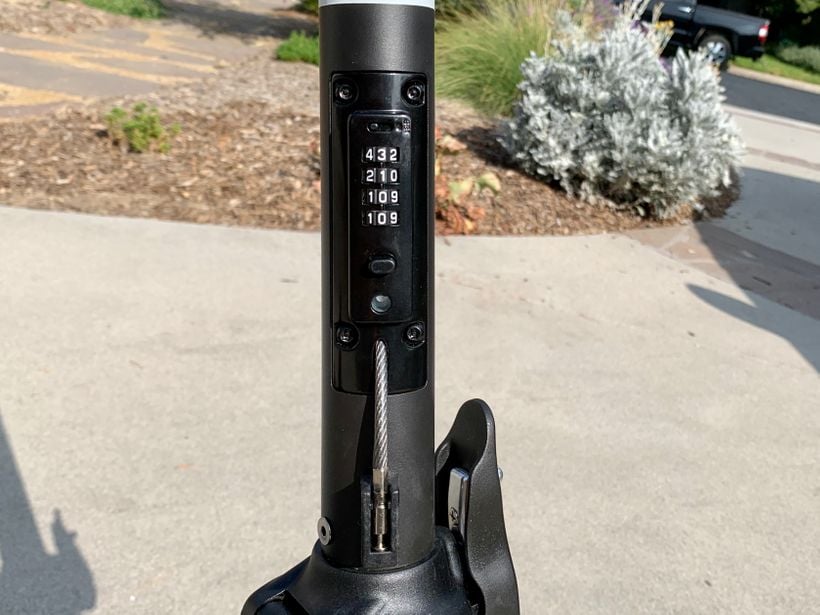

Performance Report:
Tester: Josh Frisby (190 lbs, 6.1 ft)
- Top Speed: 20 mph
- 0-15 mph: 6.3 s*
- Max Range: 50 miles
- Real Range: 25 miles*
- Braking: 4.7 meters*
- Max Incline: 15 degrees
- Optimal Incline: 9 degrees*
- Weight: 48 lbs
- Load: 275 lbs
Turboant V8 Overview:
Turboant’s back again, and this time it’s intent on not just impressing your everyday rider – no, no, with the V8, it aims to fundamentally transform your expectations.
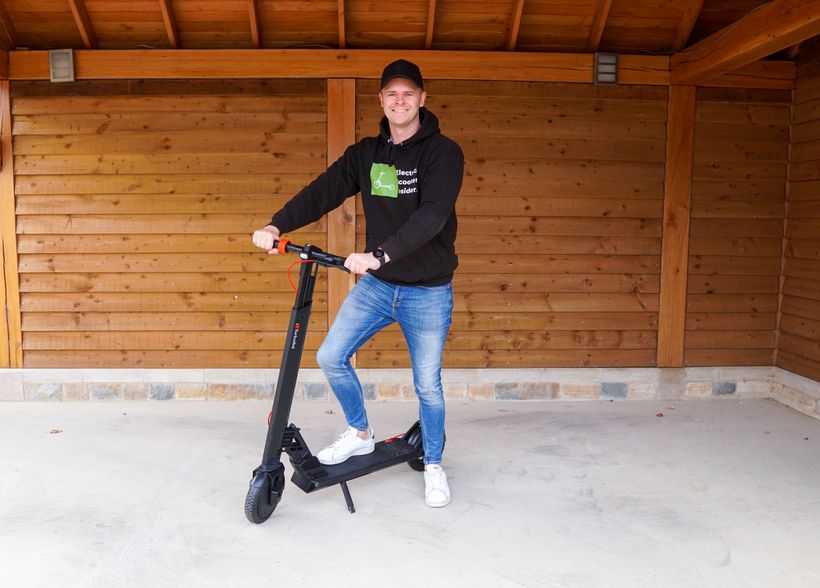
Sure, it might look like something out of a dystopian sci-fi movie, but this is a certified A-lister that, when it comes to functionality and practicality, exudes a rarified combination of features.
With a top speed of 20 mph and two batteries – one of which can be removed and replaced with a freshly charged spare – the Turboant V8 is a blast from the future that has competitors scrabbling for a response. With its affordable price tag, it'll have you mastering the art of bargain hunting.
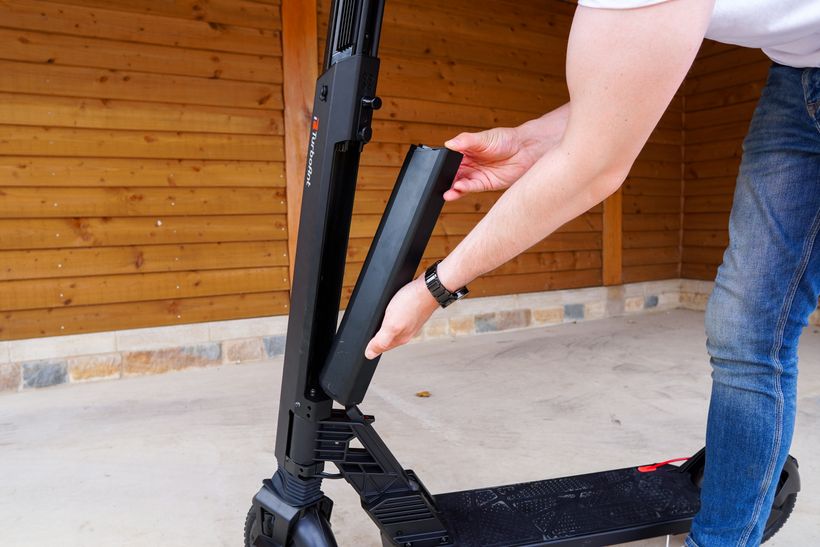
The Good:
- Two batteries, with one being detachable
- Dedicated charging dock for removable battery
- Dual rear suspension
- Plush 10-inch tires that are extra grippy
- Surprisingly good ride quality
- Equal distribution of weight across the stem and chassis ensures good handling
- Good lighting package
- IP54 water-resistance rating
The Bad:
- Display disappears in direct sunlight
- Clunky design
Why I Recommend the Turboant V8:
While the models that have preceded it in this guide have all wielded 350W motors, the V8 barges into the conversation with a 36V 450W bronco. This additional power is somewhat nullified by its added weight, but we’re still talking about a top speed of 20 mph and an acceleration rate from 0-15 mph in 6.3 seconds.
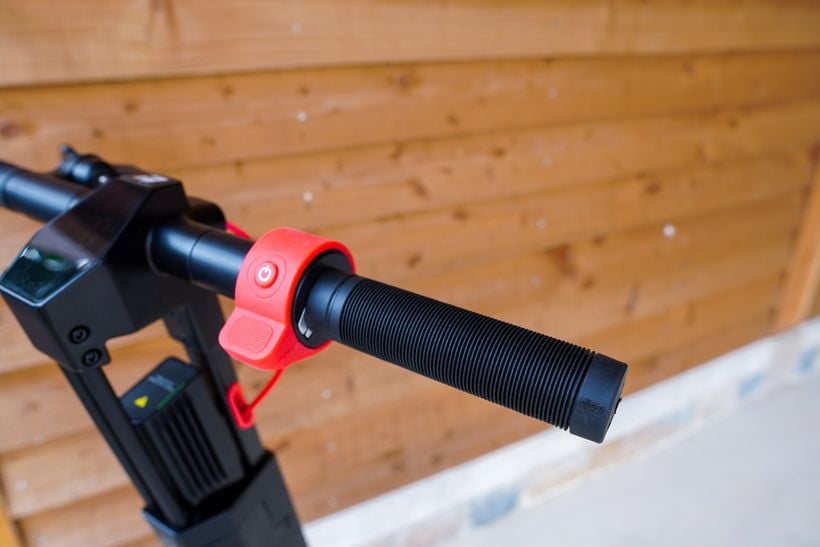
Sure, these stats aren’t going to leave you in dumbfounded awe – the V8 certainly isn’t the quickest scooter that I tested – but it’s more than suitable for most urban environments and newcomers who place convenience above all else.
Where the V8 truly gets tongues wagging, is in its groundbreaking battery capacity. Similar to the Turboant X7 Max, it comes with a detachable 36V 7.5Ah battery on its stem. The similarities end there, though; with the V8 you also get a second battery stored in the deck. Together they give you a total maximum range of 50 miles, with the potential of extending that further by purchasing spares. This is a remarkable capability for a scooter under $700.
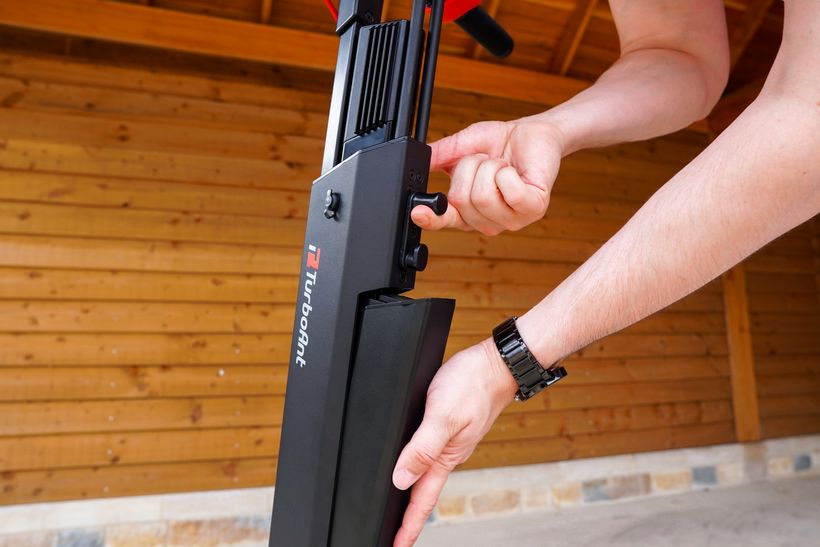
Now, the V8 is at the heavier end of the 20 mph electric scooter spectrum. While I can’t moan about that (two batteries, folks), this added baggage does somewhat inhibit its hill-climbing capabilities. If you plan on riding over gentle undulations then the V8 will happily take them in its stride – anything steeper, however, and you’ll quickly notice a drop in power.
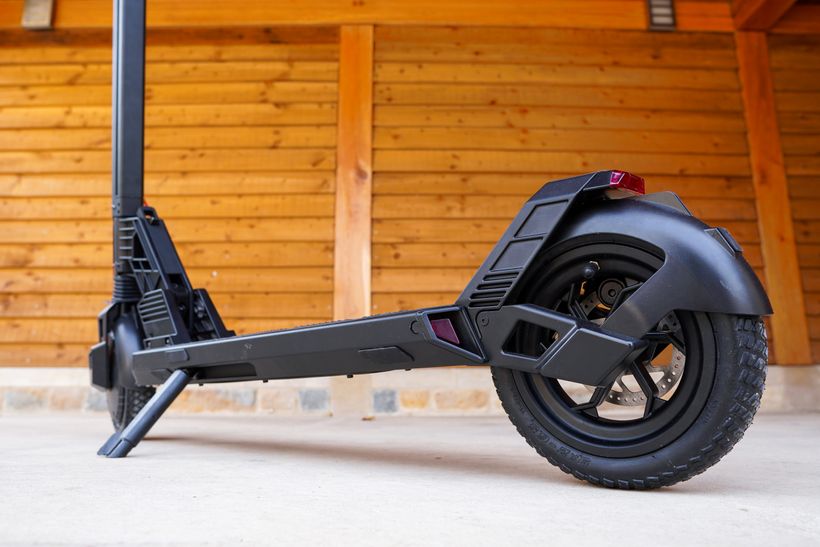
But hey, back to the positives. Turboant is the Adam Sandler of scooter brands. You know exactly what you’re getting every time: fun that you don’t have to think too hard about. Thanks to a pair of 9.3-inch pneumatic tires and its rear suspension, you’ll enjoy every mile of its range. Combined with the bulky frame, this combo delivers a well-balanced and confidence-inspiring ride that oozes control.
On most urban roads the V8 soaks up the bumps and vibrations, leaving you to feel like you’re gliding along a perfectly smooth surface. The stem and folding mechanism are solid as a rock, too, thereby eliminating any rattles and stem wobble, even at 20 mph.
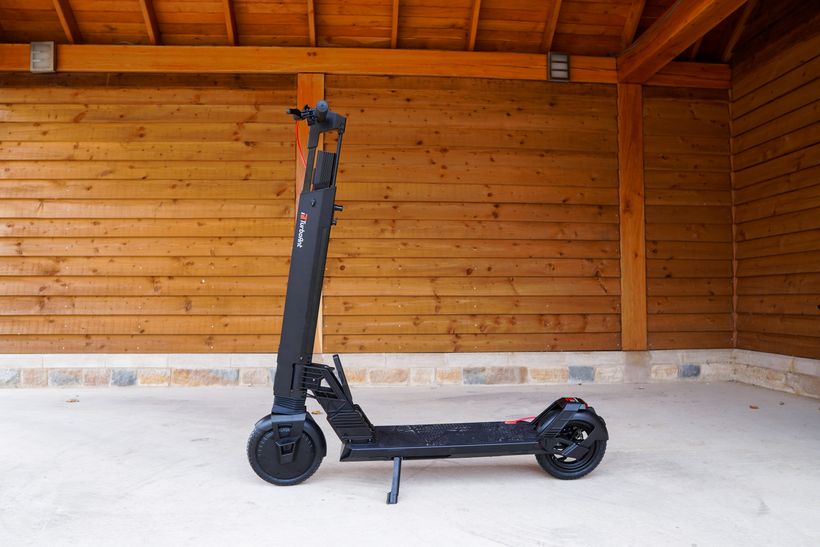
As with the X7 Max, the V8 has a dual braking system, with an electronic brake built into the front hub motor and a disc at the rear. Both operate simultaneously from the lever on the handlebars. Having the braking power funneled to each wheel usually enhances braking performance, however, under my tests, I was only able to achieve a stopping distance of 4.7 meters from 15 mph. That’s not as impressive as the X7 Max’s 3.0 meters, but it does stand up to other similarly priced models.
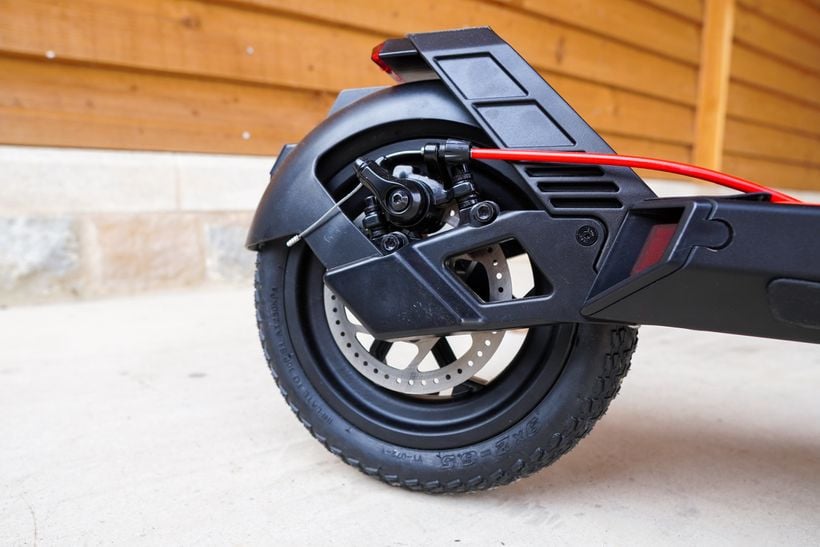
Though the V8’s boxy appearance may not be to all aesthetic tastes, one feature that does score style points is the large hexagonal display. It’s mounted in the center of the handlebars and provides a large area to display all the key riding data. One aspect that you won’t find on other scooters is the inclusion of responsive features. Here, the display responds to how hard you push on the accelerator or pull on the brake. For instance, if you pull lightly on the brakes, then just two out of the four brake bars will light up.
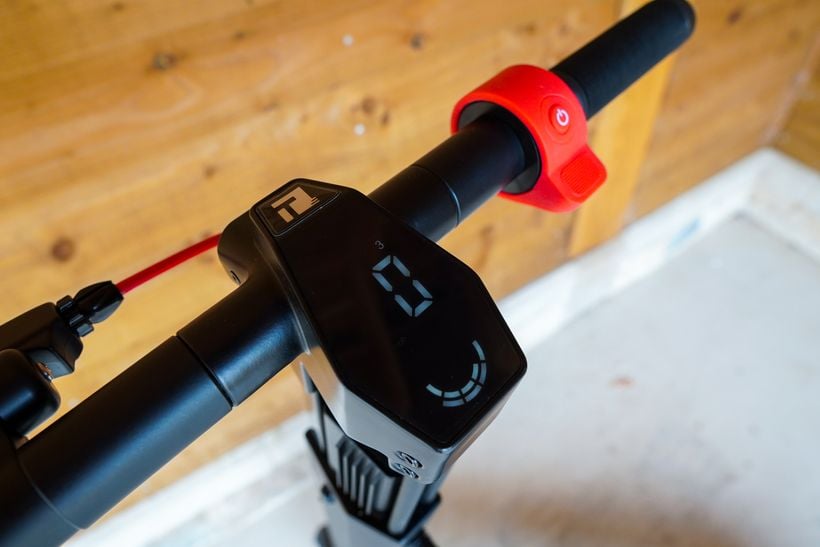
And let’s not go too hard on the V8’s looks; its chunkiness improves the scooter’s balance, making it easier to ride than the X7 Max which is a little top-heavy because of its stem-mounted battery. The solidly built frame is also exceptionally durable and has been designed to minimize the need for maintenance.
On the other hand, it means that the 48 lbs of weight is slightly more than you might want if you’re looking for an everyday scooter. However, most riders will be happy to let this go thanks to the 3-second folding system, silky ride quality, and outstanding range.
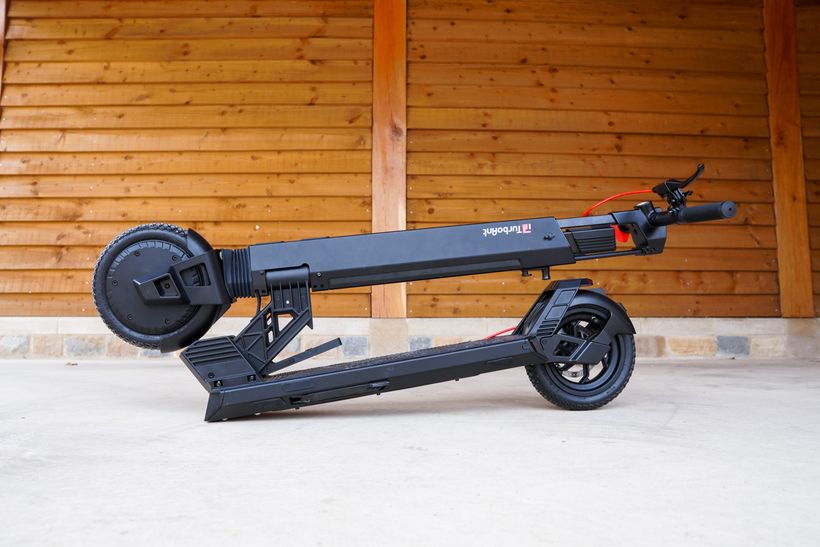
Indeed, the Turboant V8 has been developed for one, lofty purpose: to bring joy to mundane daily routines without causing any stress in the process. It’s a long-range mule that'll delight those who value practicality above all else.
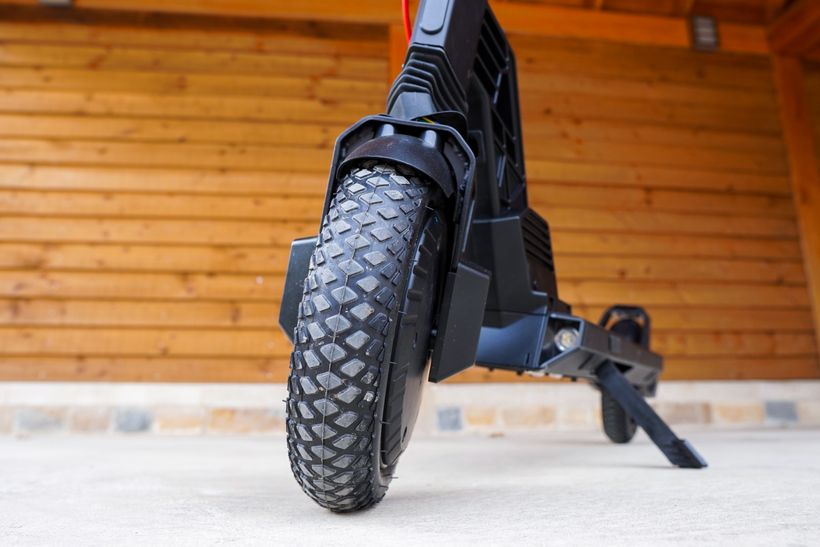
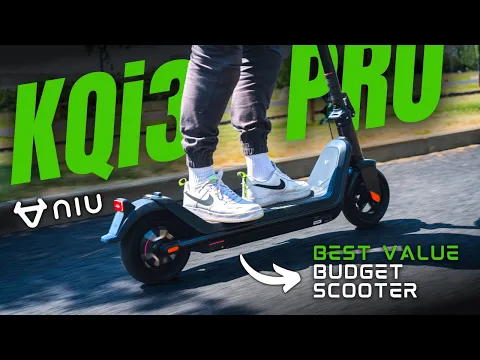
Performance Report:
Tester: Josh Frisby (190 lbs, 6.1 ft)
- Top Speed: 20 mph
- 0-15 mph: 5.0 s*
- Max Range: 31 miles
- Real Range: 22 miles*
- Braking: 2.2 meters*
- Max Incline: 11 degrees
- Optimal Incline: 9 degrees*
- Weight: 45 lbs
- Load: 265 lbs
NIU KQi3 Pro Overview:
The NIU KQi3 Pro is an albatross soaring amid a squall of swallows. That’s not to do other scooters in the sub-$800 category a disservice – it’s simply a reflection of the unparalleled build quality, design, and performance exhibited by this spectacular model.
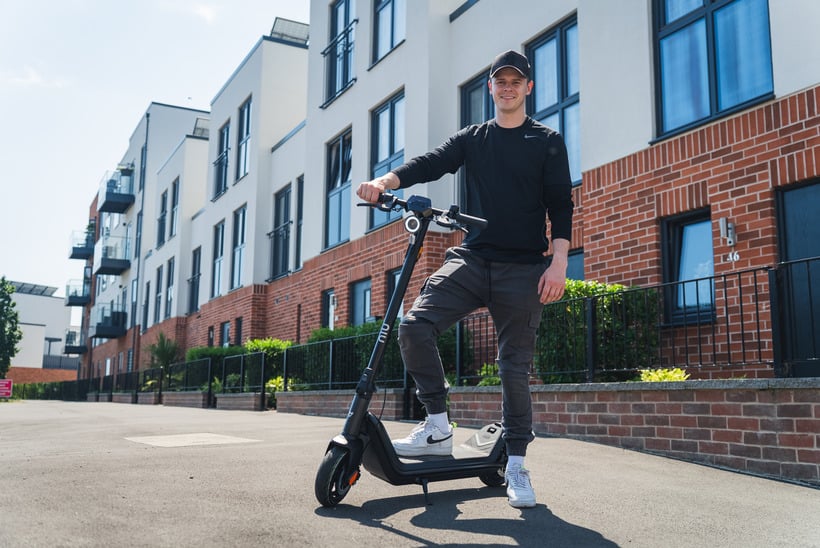
NIU is one of the world’s leading makers of electric vehicles, and boy, have they flexed their muscles. This 20 mph pyro flaunts its vehicle-grade features and exceptional ride quality like it’s no big deal, fusing addictive power with balletic poise to leave rivals chasing shadows.
Having swept up numerous awards for its design and build, the KQi3 Pro is now wowing the general public.
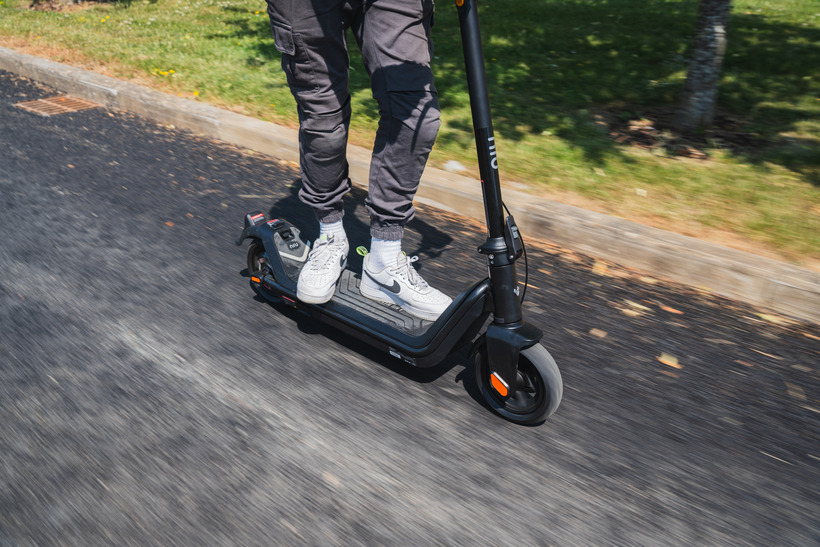
The Good:
- Award-winning electric scooter
- Best build quality among its competitors
- Premium fit and finish
- Well-balanced performance profile
- Bright, easy-to-read display
- Ergonomic controls
- Nimble thanks to its grippy tires
- Superb folding mechanism means it takes just 3 seconds to collapse
- Responsive brakes with a variable regen system
- Well suited to tall and heavy riders
- Iconic halo headlight
- Excellent battery management system
- Mobile app integration
- Comprehensive two-year warranty
- IP54 water resistance rating
The Bad:
- The taillight doesn’t flash while braking (it only gets brighter)
- With just 3 inches of ground clearance, you need to avoid curbs and other obstacles
Why I Recommend the NIU KQi3 Pro:
The hype around the NIU KQi3 Pro has seen Electric Scooter Insider inundated with requests to review it – and the buzz is wholly justified. Let’s look at why.
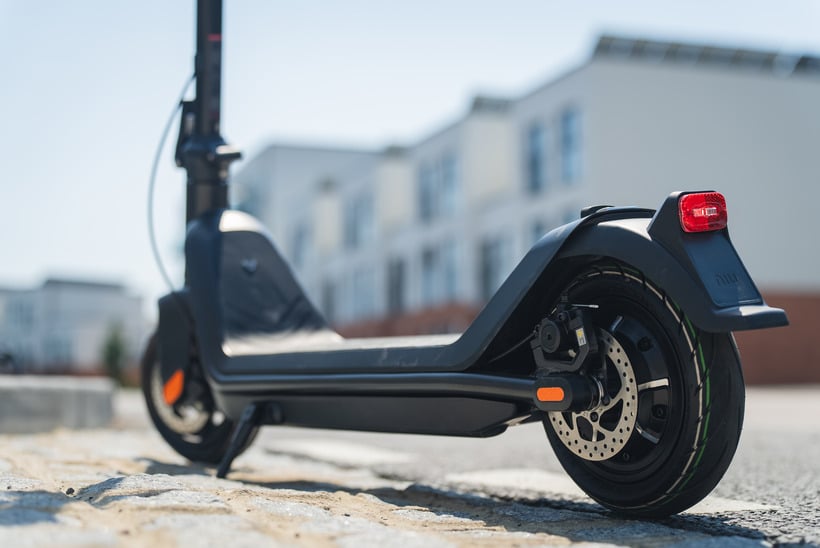
I’ll begin with its performance. The Pro sports a 48V 350W motor that produces a peak power output of 700W and a top speed of 20 mph. This is 3 mph faster than its less powerful sibling the KQi2 Pro, while its acceleration rate of 0-15 mph in 5.0 seconds is 17% quicker.
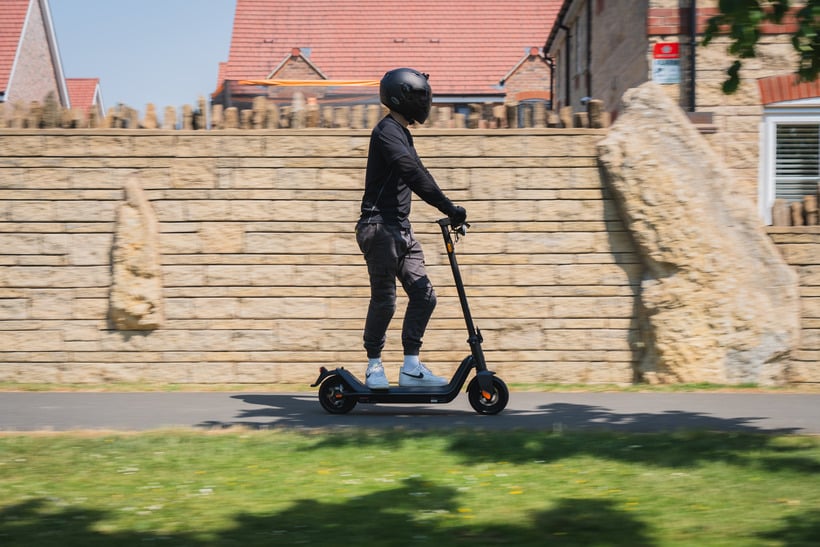
These stats are impressive – but the real beauty is in how it performs at high speed. Thanks to its low center of gravity, well-calibrated rake angle, and balanced profile, it guarantees stability regardless of how hard you’re pushing down on the supremely ergonomic thumb throttle.
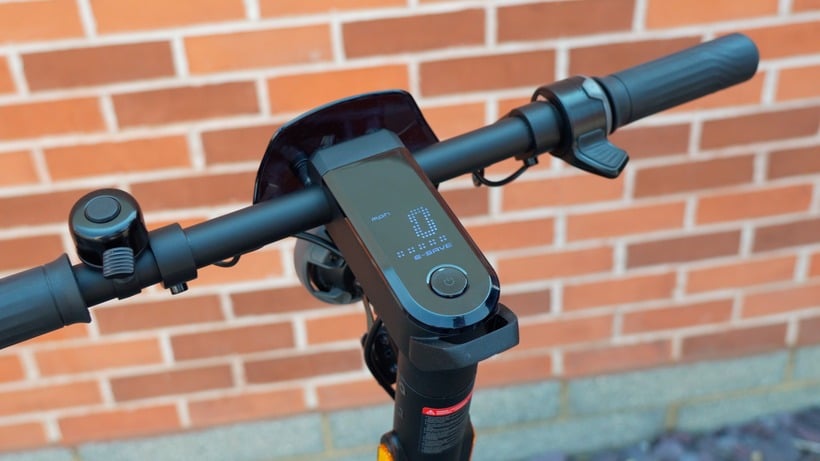
Equipped with handlebars that measure 21.3 inches – as well as premium rubber handgrips and an exceptionally bright display – this is a scooter designed from top to bottom to make you feel secure and in control. The grippy deck, which sits in the middle of an elegantly sweeping chassis, is 27% longer and 29% wider than the one that you’ll find on the KQi2 Pro – and it looks like a penny skateboard, which earns style points in my book.
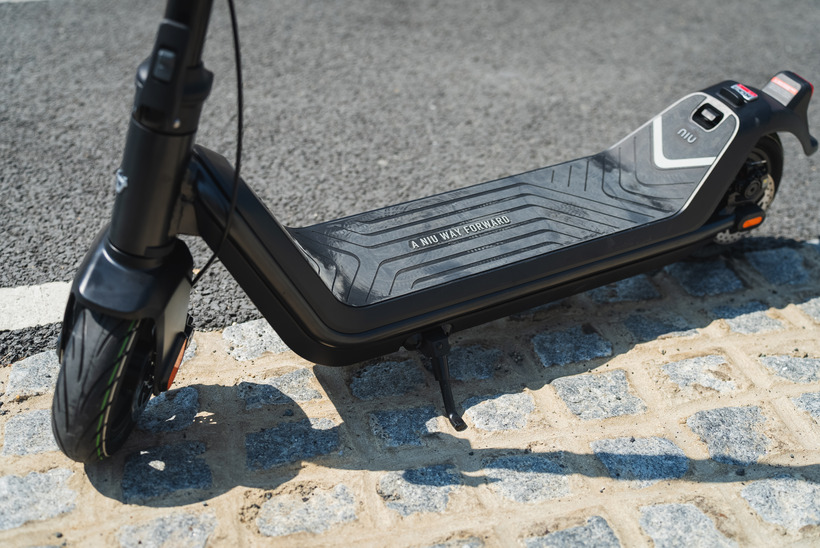
Elsewhere, the 9.5-inch tubeless tires afford ample shock absorption, exceptional maneuverability, and considerable traction. Being 25% thicker than those that you’ll find on scooters of a similar ilk, they’re perfect for weaving from side to side and leaning aggressively into corners.
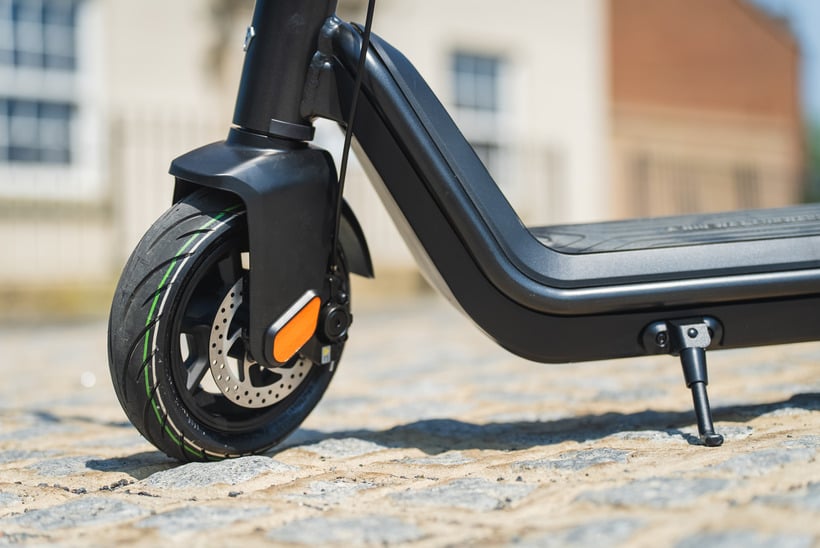
You’ll also be glad to know that the brakes are outstanding. With two discs installed alongside a regen brake, they’ll bring you to a sharp stop from 15 mph in just 2.2 meters.
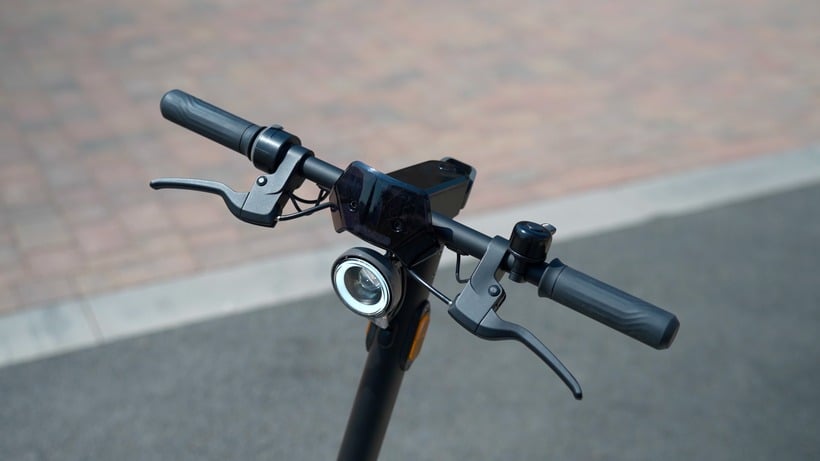
But the real clincher is the fact that the regen brake works independently from the discs. It’s activated as soon as you release the throttle – and what’s more, its strength can be adjusted via the Pro’s nifty mobile app. It’s the only sub-$800 scooter to sport such a setup.
Through the app, you can also modify the accelerative strength, record rides, cap the top speed, and activate a digital lock. This is yet another feature that separates the KQi3 Pro from other scooters in its price class.
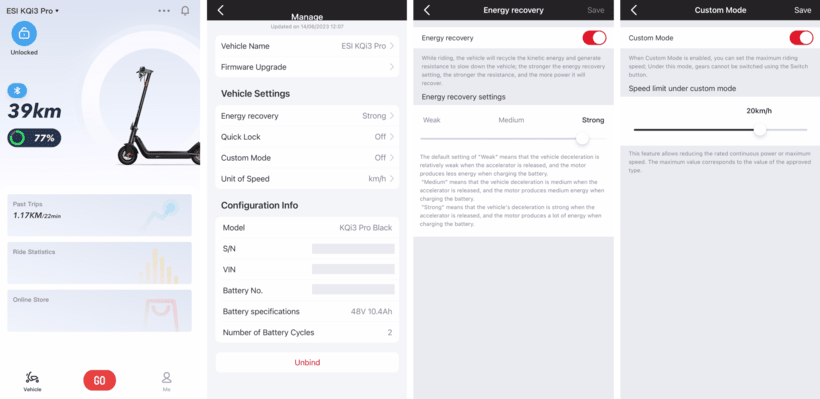
As too, is its iconic halo headlight. It's a thing of beauty; the outer ring stays lit the entire time, while a bright beam illuminates the way forward when the lights are switched on. Supported by a clear and visible taillight, the KQi3 Pro ticks the lighting box. It would benefit from just one improvement, though – it would be better if the taillight flashed when you brake, as opposed to just glowing brighter.
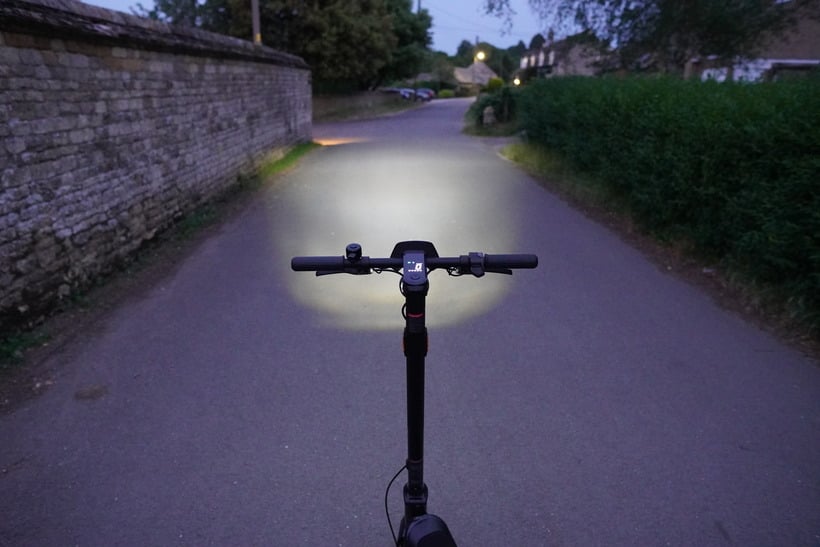
And did I mention that the KQi3 Pro comes with two patents? One is for its exceptionally smooth folding mechanism, which makes collapsing the scooter super convenient. Though it’s not the lightest model around, it can easily be carried in short bursts and stored in the trunk of your car.
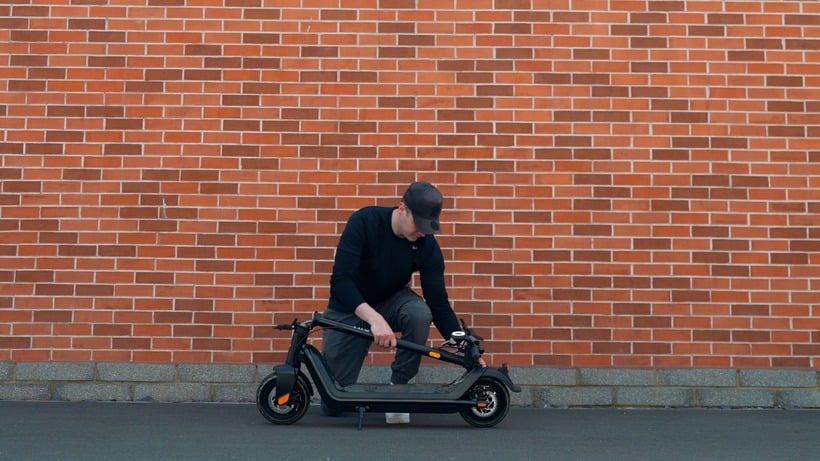
The other patent can be found on the battery management system that offers 14 different types of protection for the scooter’s 486Wh unit. This ensures that your maximum range of 31 miles (or 22 miles in realistic conditions) can be relied on for years to come.
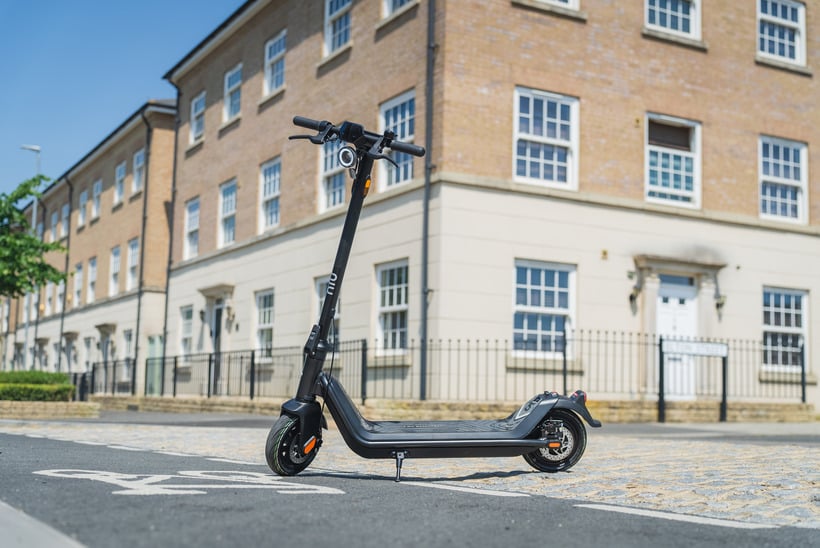
And believe me when I say that this is a scooter that you’ll want to ride for years. Everything about the KQi3 Pro exudes class – it’s a genuine bargain that will delight riders of any experience level.
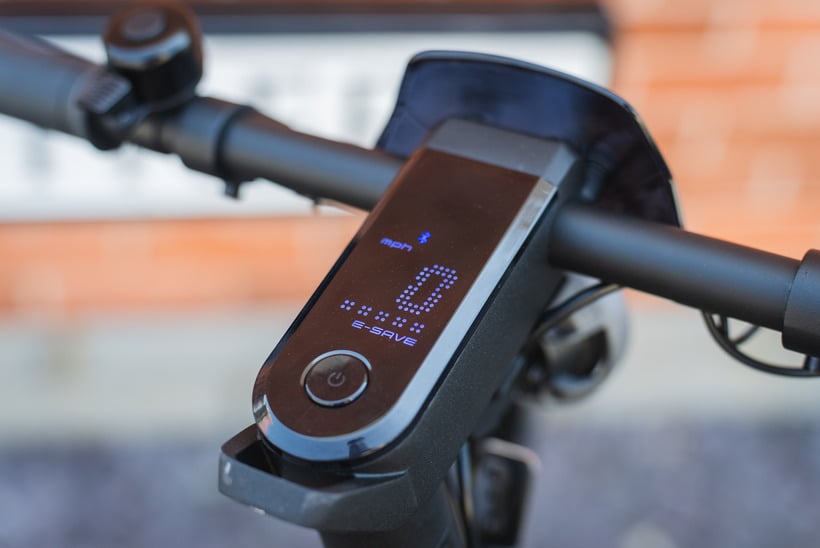
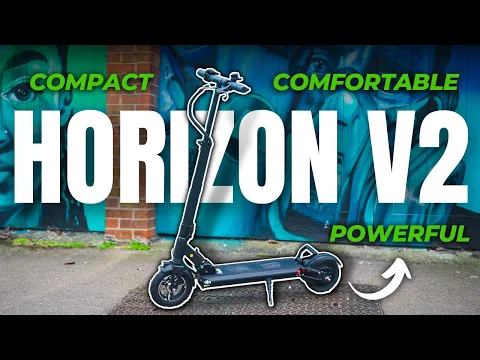
Performance Report:
Tester: Josh Frisby (190 lbs, 6.1 ft)
- Top Speed: 23 mph
- 0-15 mph: 4.7 s*
- Max Range: 30 miles
- Real Range: 23 miles*
- Braking: 5.0 meters*
- Suspension: 6/10*
- Max Incline: 15 degrees
- Optimal Incline: 9 degrees*
- Weight: 42 lbs
- Load: 265 lbs
Horizon Overview:
The Horizon has been a stalwart of the commuter scooter scene for a long time now – and its popularity is deserved. Tough, reliable, and low maintenance, it marries practicality with zippy performance to delight new riders and experienced everyday enthusiasts alike.

And now, we have the Horizon V2. Building on the success of its predecessor, it brings a new waterproof display, an ergonomic thumb throttle, and a nifty carry handle to the party.
But the headlines remain the same: the Horizon V2 is not only one of the fastest scooters in its price category but also one of the cheapest to feature a full suspension system.
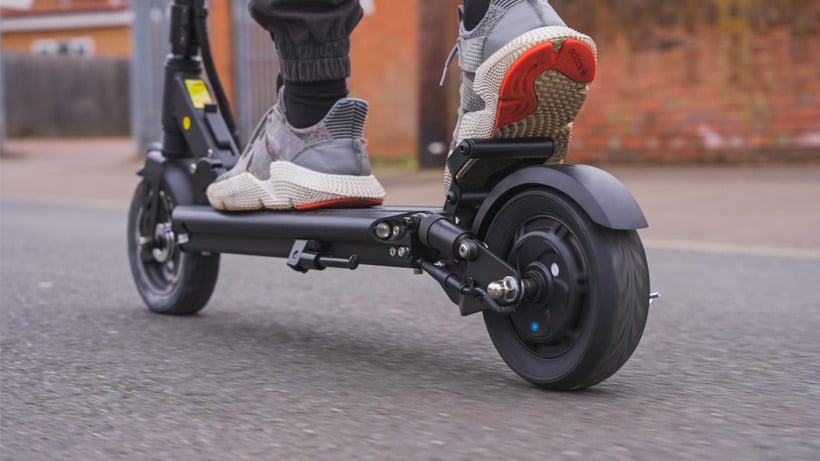
The Good:
- Very popular
- Top performer in its price class
- Nippy acceleration
- Great ride quality
- One of the cheapest scooters to be equipped with front and rear suspension
- Extremely compact
- Telescopic stem allows riders to adjust the handlebar height
- Ergonomic controls
- Low maintenance
The Bad:
- No water-resistance rating
- Brakes could be better calibrated
Why I Recommend the Horizon:
Armed with a spiky 48V 500W motor that can summon a peak power output of 800W from its depths, the Horizon V2 hits a top speed of 23 mph with ease and wizzes from 0-15 mph in a cool 4.7 seconds.
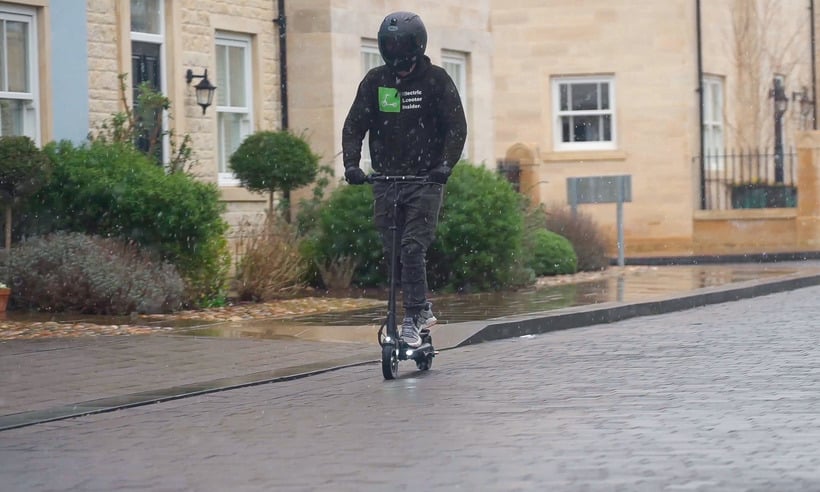
This may sound like quite the burst of speed for what’s ostensibly an everyday commuter scooter, but its attitude is controlled by a 20A controller and the new thumb throttle. Together, they ensure that power delivery is smooth.
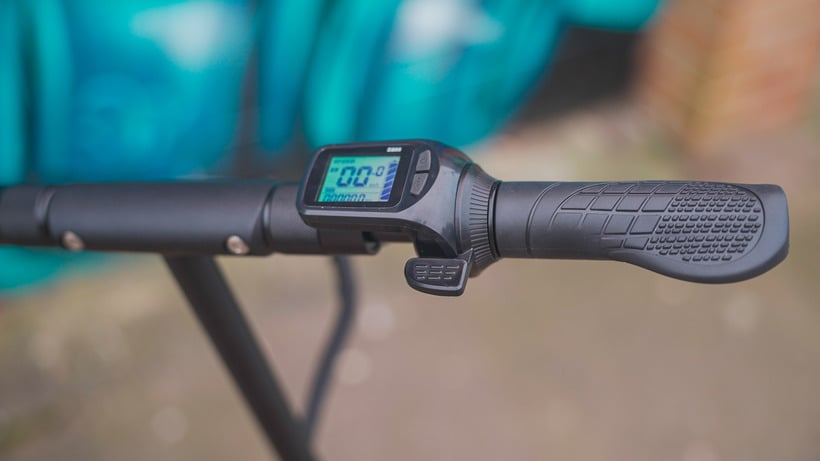
Further control and stability are facilitated by the handlebars, which at 23.2 inches are among the widest that I’ve ever tested on an entry-level scooter. Among them, you’ll find the throttle and display. Oddly, the latter comes with an IP66 water-resistance rating, but the rest of the scooter doesn’t feature any rating at all.
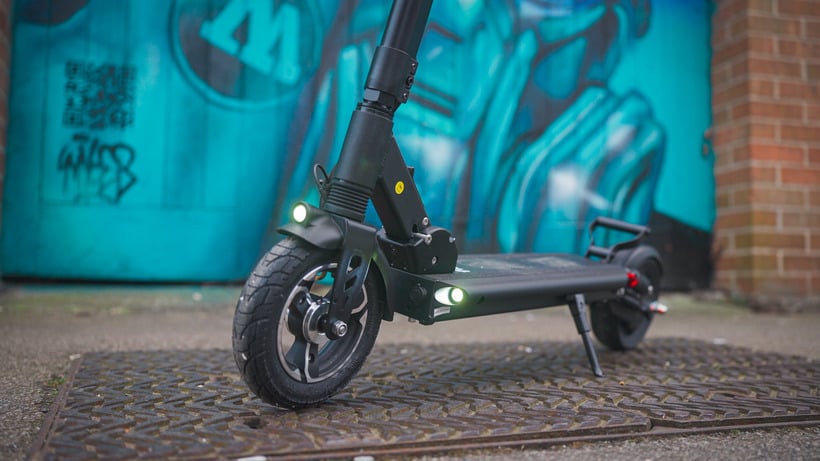
Elsewhere, the deck is spacious and lined with two grip strips, while the frame (though lacking in water resistance), is tough yet relatively lightweight. This, allied with the nimble profile of the front air-filled tire, fosters a strong sense of maneuverability.
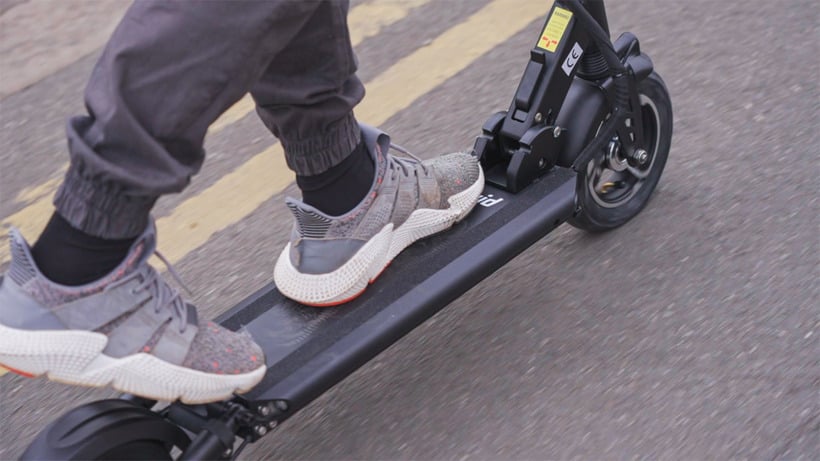
With rear tires typically more prone to punctures, the brains at Fluid have astutely opted for a solid tire here. It also features a front-on profile that’s more square and it’s 0.5 inches thicker. Together, these increase the amount of traction that it produces when accelerating. Working in cahoots with the rear-mounted motor, the tire successfully harnesses the torque emitted to propel you forward.
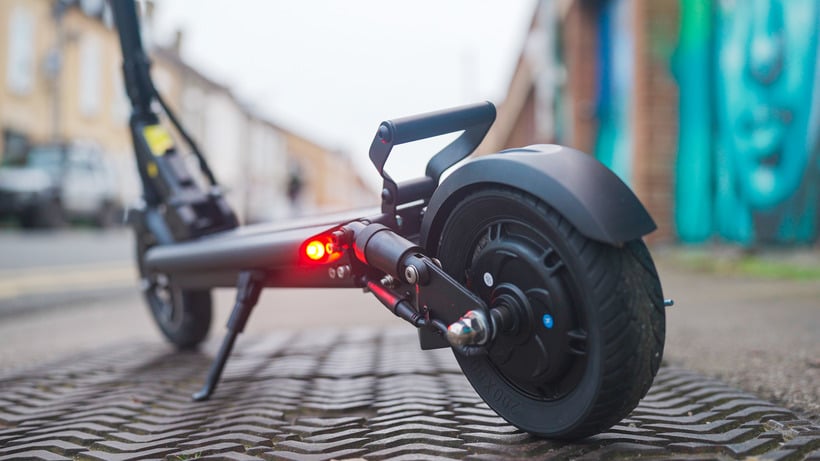
One area that did disappoint me slightly was the Horizon’s braking performance. In its defense, the rear drum and regen brake are extremely low maintenance, but the 5.0-meter stopping distance from 15 mph is average at best.
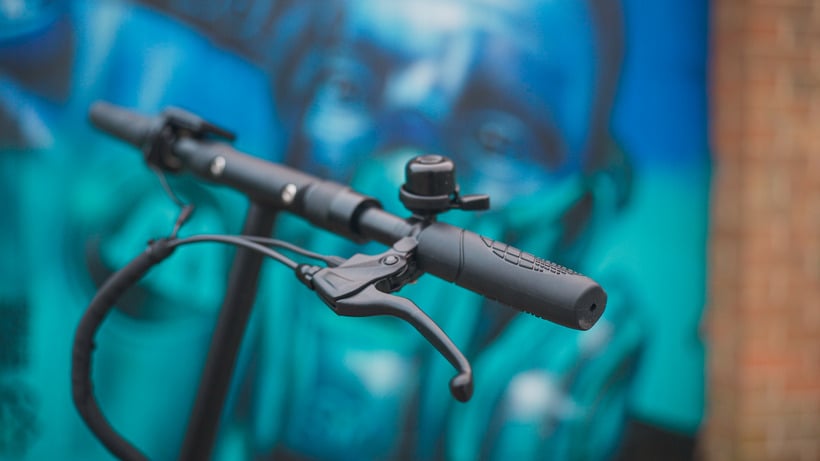
The model’s lighting rig is also a little underwhelming. It isn’t short of lights, but the main headlight is mounted too low for night rides – I strongly recommend investing in an extra clip-on. I am, however, a fan of the LEDs at the front and rear of the deck; the rear lights even flash when you brake, which is a tick in the safety box.
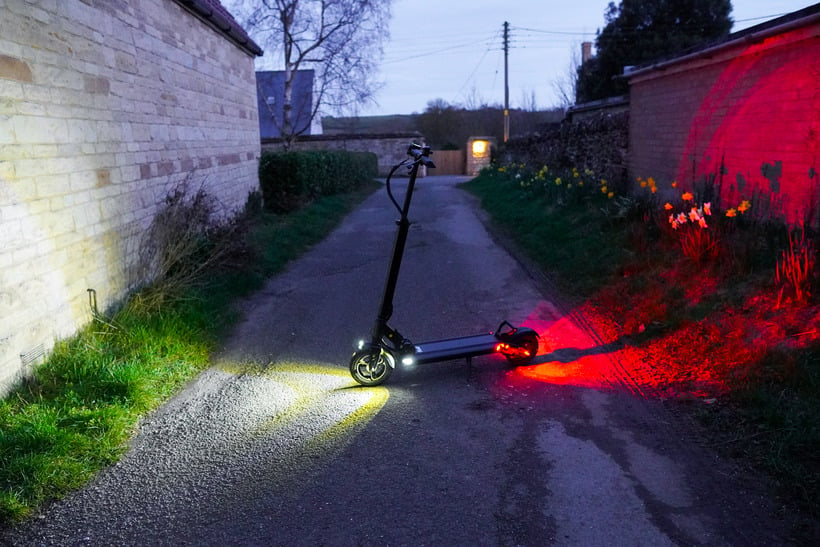
What isn’t average, however, is the Horizon’s front and rear suspension. It’s one of the cheapest scooters to feature such a setup; it effectively absorbs all the shocks and vibrations from city streets to leave you with a feeling akin to gliding.
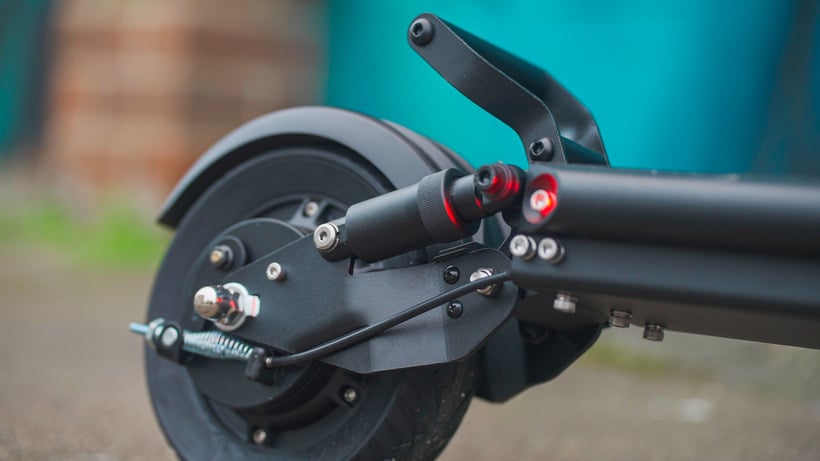
It’s no slouch when we switch the focus to range, either. The Horizon can be purchased with either a 10.4Ah or 13Ah battery. The former will grant you a maximum range of 23 miles, or 17 miles in realistic conditions. For an extra $80, the 13Ah option will boost you to 30 miles (or 23 miles in real-world terms).
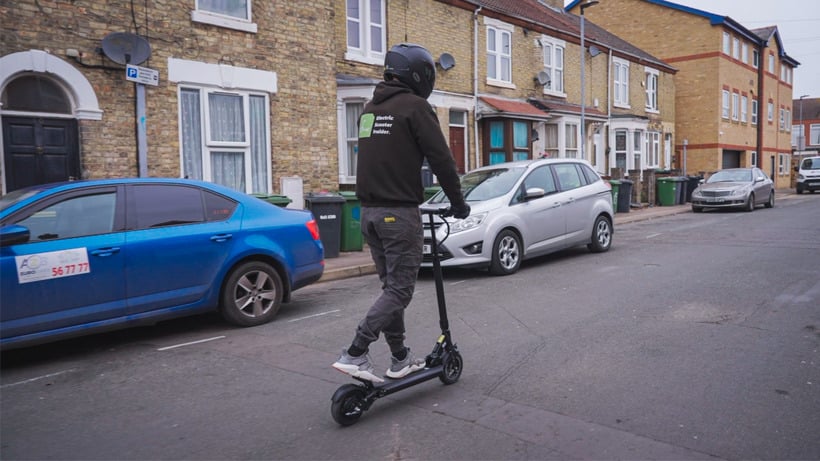
Being a commuter scooter, its portability game needs to be on point. Well, like its predecessor, the V2’s handlebars fold, while the main folding mechanism at the foot of the wobble-free stem is poetry in motion. You can have the scooter fully collapsed in seconds. And, if you don’t have time to fold it, but simply need to hoist it up some stairs, the new carry handle means you can lift it with ease.
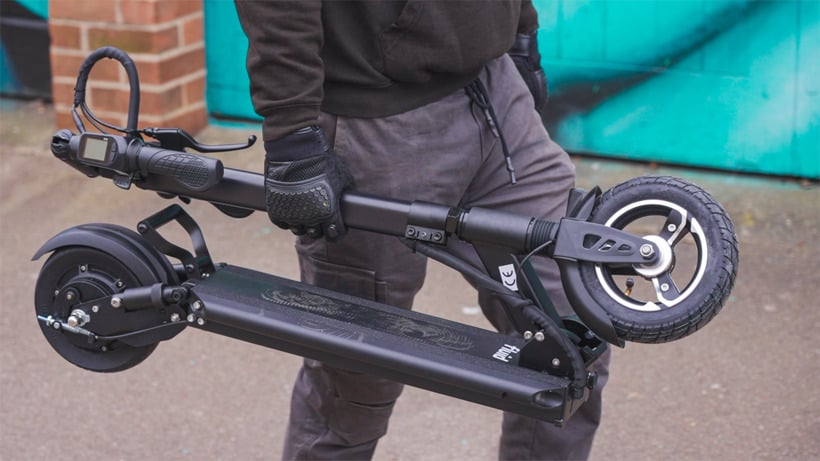
But in reality, the last thing you’ll want to do is carry this beauty. The Horizon V2 is a fun, reliable, and low-maintenance ride for anyone who wants to experience the joys of an electric scooter. The V2 is poised to maintain dominance in the commuter category for years to come.
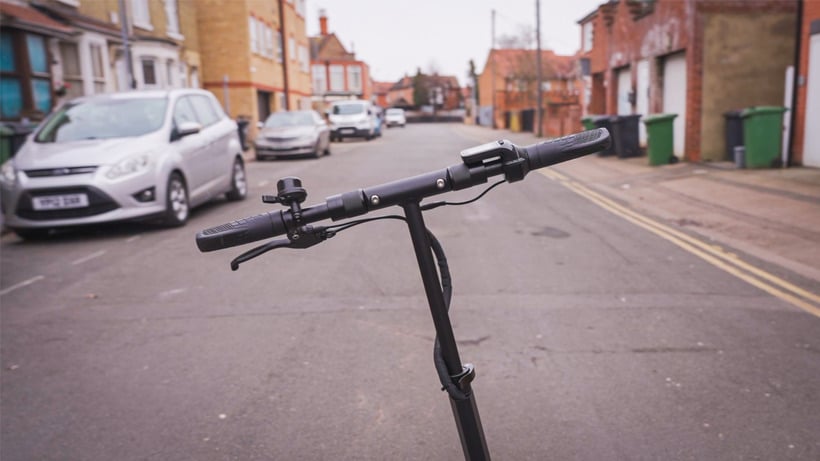

Performance Report:
Tester: Josh Frisby (190 lbs, 6.1 ft)
- Top Speed: 21 mph
- 0-15 mph: 5.7 s*
- Max Range: 34 miles
- Real Range: 23 miles*
- Braking: 3.4 meters*
- Suspension: 6/10*
- Max Incline: 10 degrees
- Optimal Incline: 6 degrees*
- Weight: 39 lbs
- Load: 265 lbs
Apollo Air Overview:
Is there a hotter brand than Apollo in the electric scooter industry right now? Every new release is an absolute slam-dunk – and the Air 2023 is no exception.
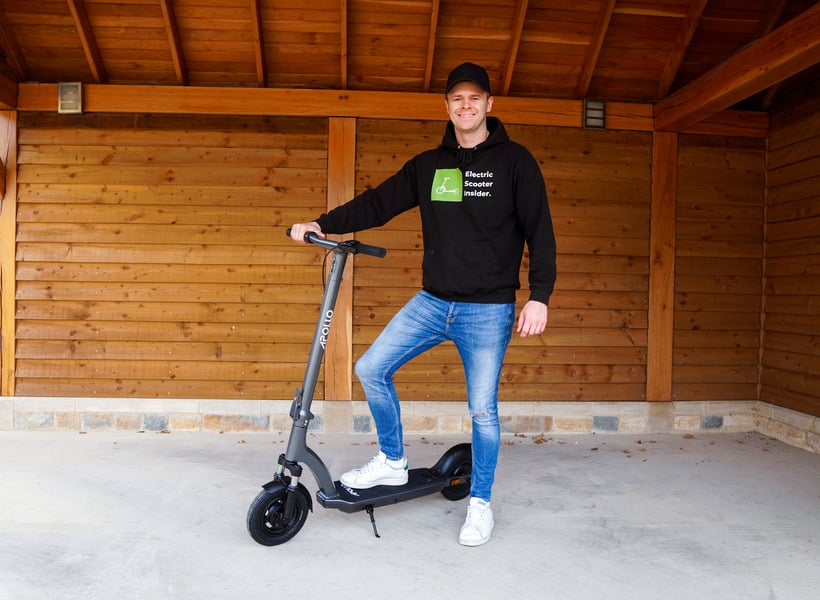
The Air 2023 is a product of Apollo’s tried-and-tested process of improving on existing models by listening to customer feedback. It takes all that I loved about 2022’s vintage and adds a clutch of outstanding upgrades. The brand has truly gone above and beyond to ensure it continues improving on an already award-winning formula.
So, what can you look forward to? Try a new, supremely ergonomic cockpit, an improved IP66 water-resistance rating, self-healing tires, an upgraded folding mechanism, and next-level turn signals. Combined with an assortment of blue ribbon features that remain unchanged, the Air 2023 is yet another triumph from the brand with the Midas touch.
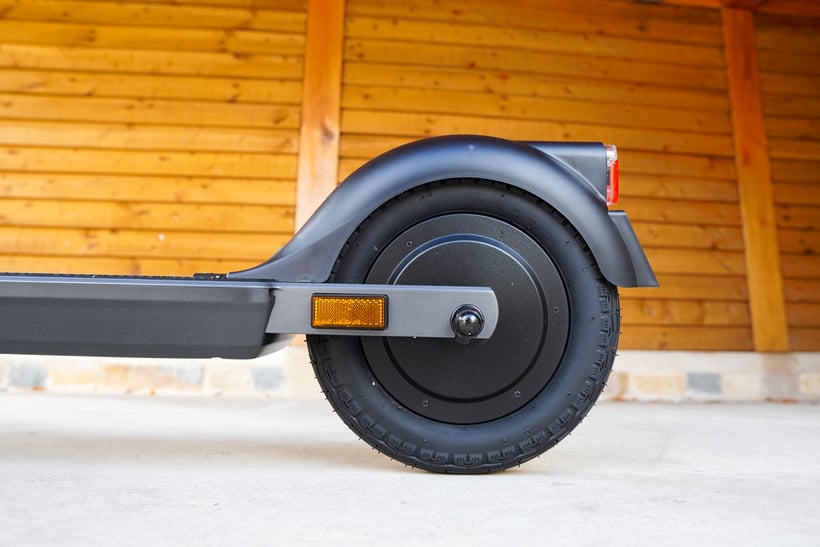
The Good:
- Best-in-class ride quality
- Well-balanced performance
- Front fork suspension promises a comfortable ride
- Self-healing, plush 10-inch tires
- Regenerative braking system recharges the battery by up to 10%
- Quick and easy folding mechanism
- Finely-tuned build quality (including 21700 battery cells)
- Bright headlight with integrated handlebar turn signals
- Mobile app allows for customized performance
- Excellent 10,000 km warranty
- Low-maintenance
- Fenders hug both tires to prevent splashback
- Grippy deck
- Anti-corrosive graphite paint
- IP66 water-resistance rating
The Bad:
- Display gets washed out in direct light
- Rear light doesn’t flash when braking
Why I Recommend the Apollo Air:
Let’s start with the Air’s plucky performance. Its 36V 500W motor delivers a top speed of 21 mph and hits 15 mph from a standstill in 5.7 seconds. Commuters, students, and casual riders will revel in this zippy yet controlled power.
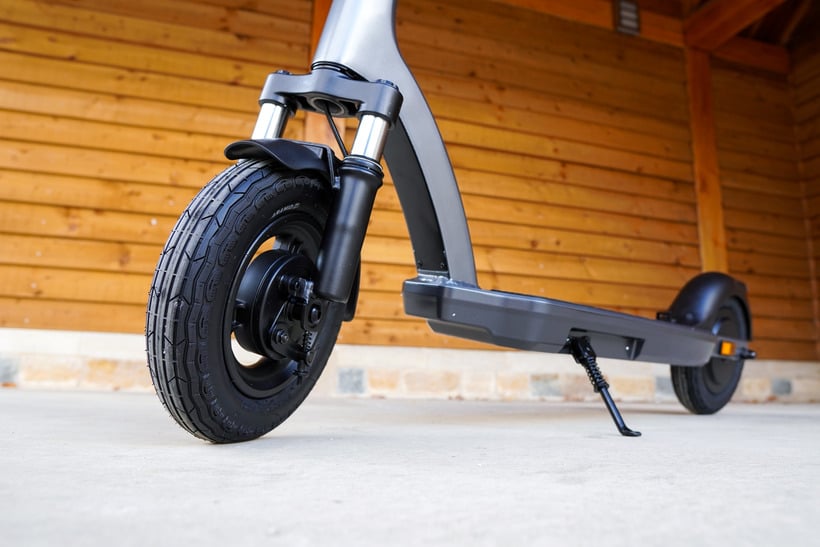
Allied with this is the Air’s outstanding handling. Equipped with wide handlebars that guarantee balance and stability, the scooter’s lightweight profile makes it a breeze to maneuver. The deck, meanwhile, is grippy, with ample space to find a comfortable riding position.
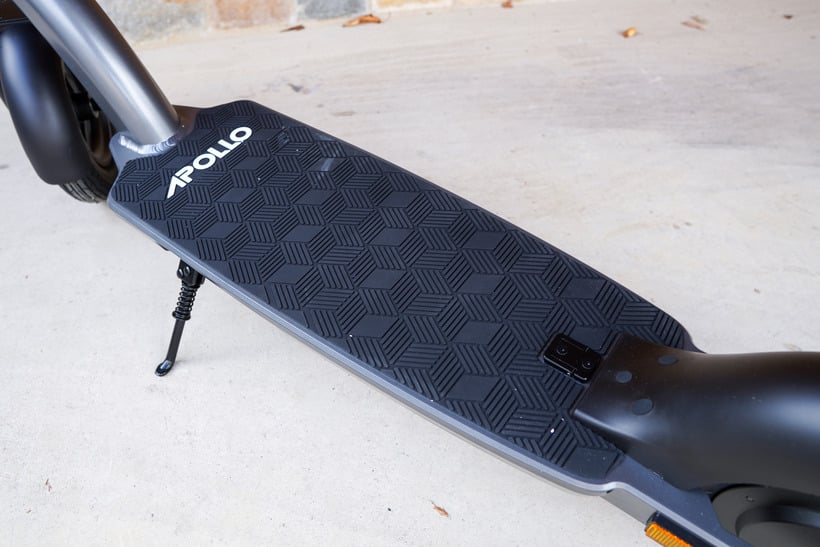
And then you have the upgraded cockpit. The one found on the Air 2022 barely needed improving, but Apollo’s gone and done it anyway by introducing 8th-generation paddles for the regen brake and accelerator. These also have buttons for your lights and riding modes built in. They’re a case study in elegant ergonomics.
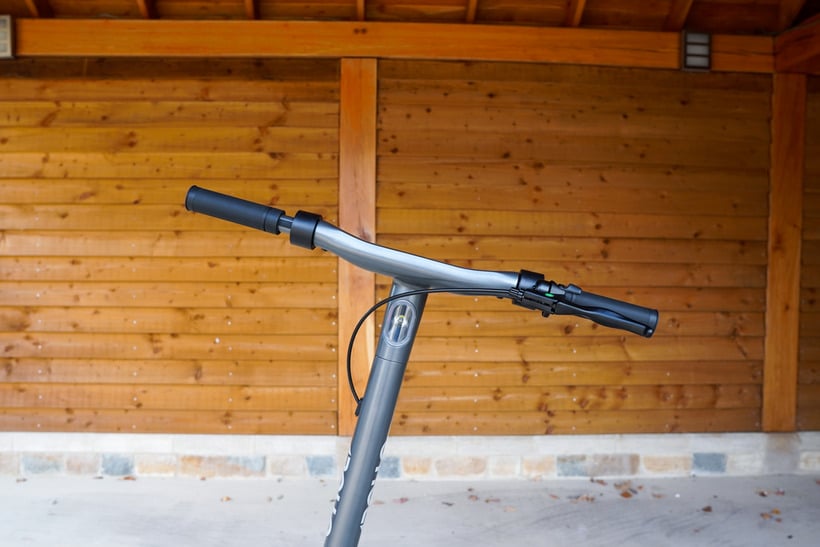
Elsewhere, the frame retains the same anti-corrosive graphite paint that made its predecessor so adept as an all-weather scooter – except now it comes with an even better IP66 water-resistance rating. This is exceptionally rare to find on a model at any price.
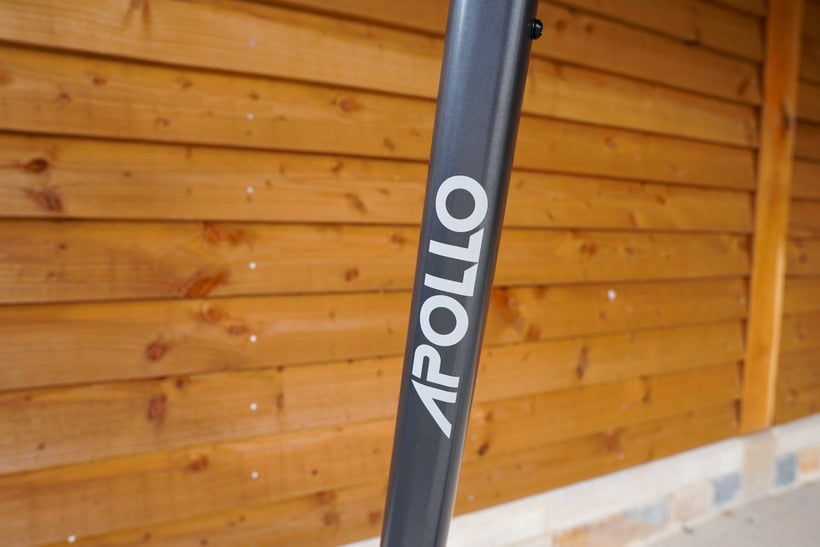
Unpredictable city streets demand a strong set of brakes of course, and I’m pleased to confirm that the Air 2023 takes its responsibilities seriously. The front drum and rear regenerative braking system will bring you to a safe stop from 15 mph in 3.4 meters, beating the 5.0-meter average of other entry-level scooters by some margin.
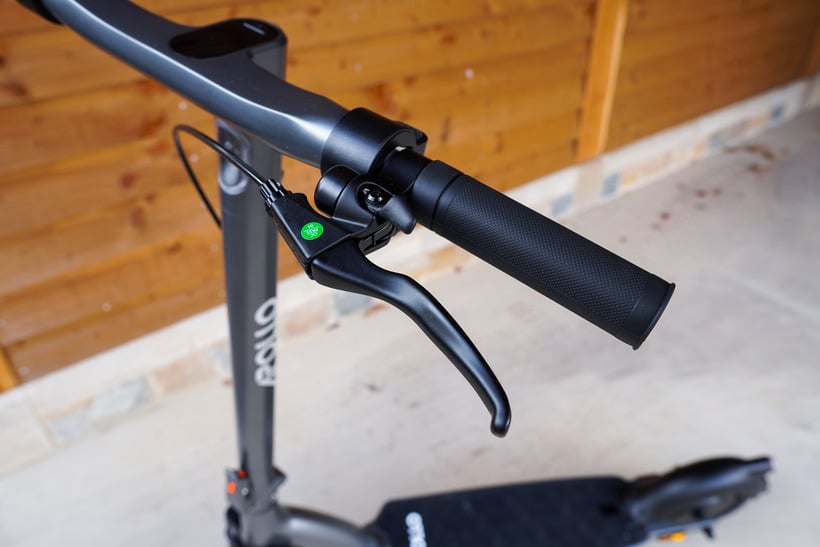
What’s more, the regenerative brake can be used without the drum. This helps to recharge the battery by up to 10% while sparing the mechanical brake from wear and tear.
Now, the Air is called the Air for a reason – weighing just 39 lbs, it’s as light as a feather. This, combined with the new and improved folding mechanism – which eliminates stem wobble – establishes it as a portable thoroughbred. It can be collapsed in mere seconds and carried with ease.
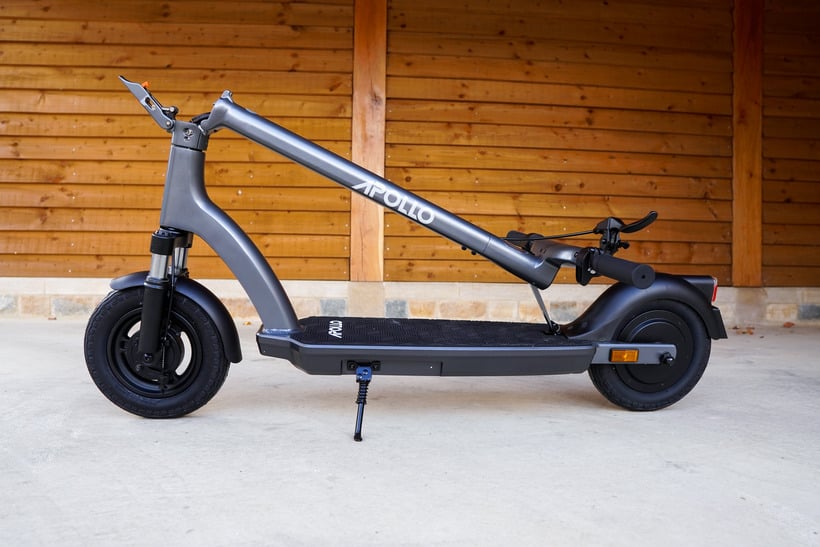
Some aspects of the Air’s design have been kept the same – including the sumptuous front fork suspension and lavish air-filled tires. Yet, even here, subtle changes are afoot, with the tires now self-healing. This adds a new layer of low-maintenance charm which will go down well with everyday riders who don’t have the time or knowledge to repair their scooter.
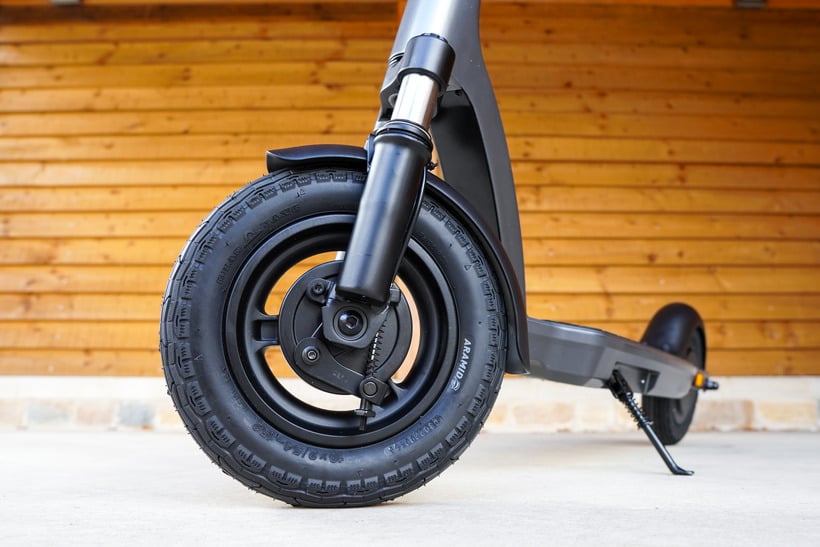
Another feature that’s been retained is the mobile app. This allows you to record your rides and adjust key aspects of the scooter’s performance, such as the accelerative and regen braking strength. You can also modify the top speeds of each riding mode, view the health of your battery, and activate an electronic lock.
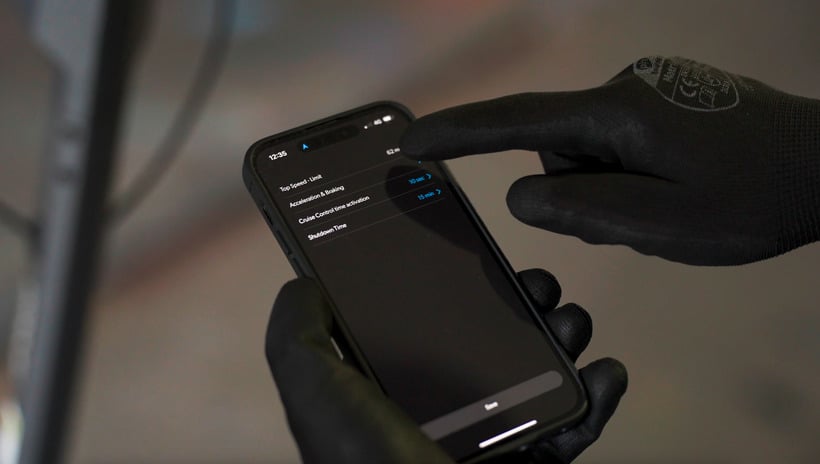
Then there’s the premium 15Ah battery. This bad boy produces a maximum range of 34 miles, or 23 miles if you’re riding fast. That’s more than enough range for everyday pursuits.
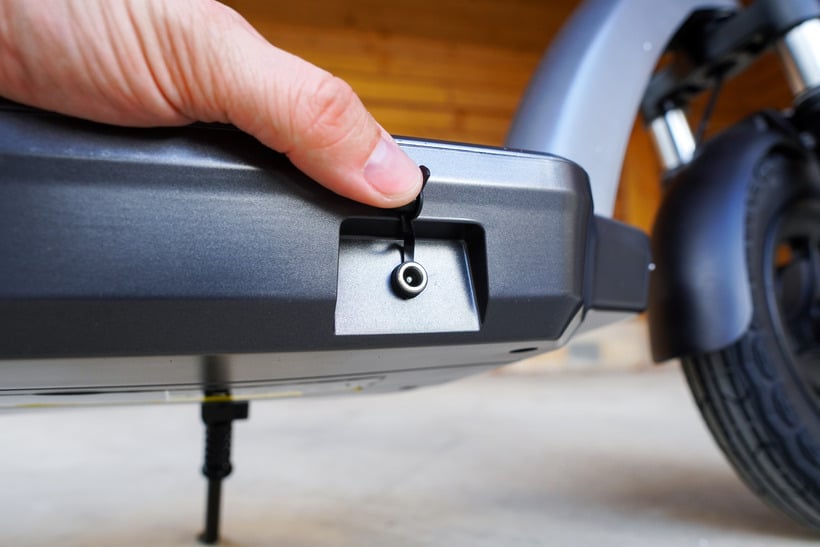
And of course, you have the lighting rig. Here, one of the Air’s crowning glories can be found: new turn signals that have been built into the tips of the handlebars. Their next-level design guarantees visibility from every angle. The adjustable headlight, meanwhile, is sparkling and well-positioned, while the taillight is bright and visible.
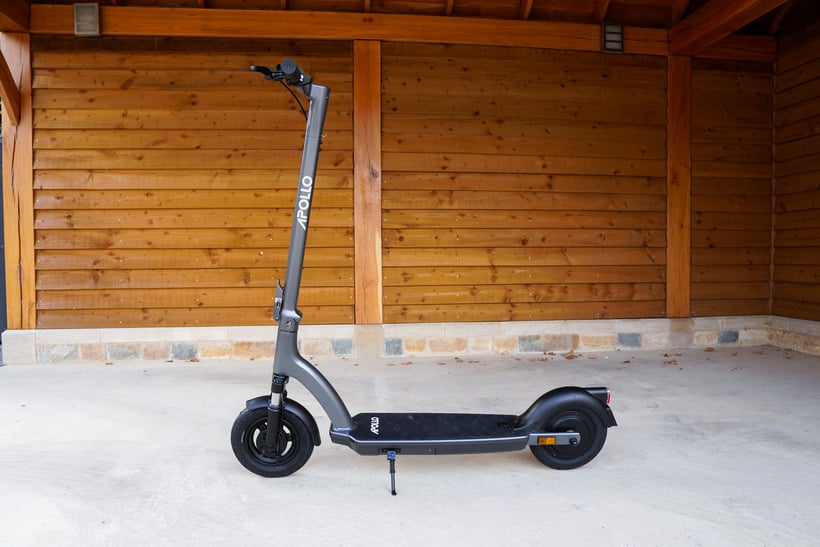
But then everything about the Apollo Air 2023 shines bright. It’s yet another statement of intent from a brand that refuses to rest on its laurels.
Compare 20 MPH Electric Scooters
The table below compares the electric scooters across top speed, acceleration, motor power, performance, specs, price, and more.
Turboant X7 Max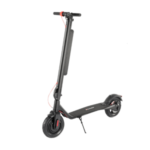 | GoTrax G4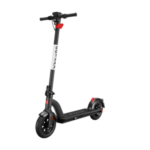 | Turboant V8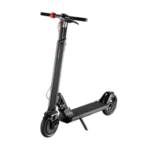 | NIU KQi3 Pro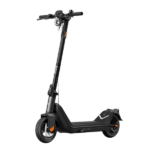 | Horizon V2 (13Ah)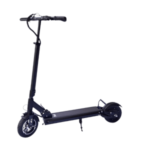 | Apollo Air 2023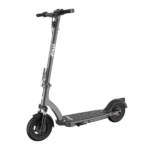 |
|
|---|---|---|---|---|---|---|
| Where to Buy | Turboant | GoTrax | Turboant | NIU Official | Fluid Free Ride | Apollo |
| Price | $429.98 | $449 | $569.98 | $559 | $749 | $849 |
| Award | Best Under $500 | Best Under $600 | Best Under $700 | Best Under $800 | Under $900 | Under $1,000 |
| Review | Review | Review | Review | Review | Review | Review |
| Performance | ||||||
| Top Speed | 20 mph | 20 mph | 20 mph | 20 mph | 23 mph | 21 mph |
| 0-15 MPH | 6.9 s | 6.3 s | 6.3 s | 5.0 s | 4.7 s | 5.7 s |
| Max Range | 32 miles | 25 miles | 50 miles | 31 miles | 30 miles | 34 miles |
| Tested Range | 18 miles | 14 miles | 25 miles | 22 miles | 23 miles | 23 miles |
| Braking | 3.0 meters | 6.0 meters | 4.7 meters | 2.2 meters | 5.0 meters | 3.4 meters |
| Max Incline | 15 degrees | 15 degrees | 15 degrees | 11 degrees | 15 degrees | 10 degrees |
| Optimal Incline | 9 degrees | 9 degrees | 9 degrees | 9 degrees | 9 degrees | 6 degrees |
| Specs | ||||||
| Motor | 36V 350W | 36V 350W | 36V 450W | 48V 350W | 48V 500W | 36V 500W |
| Throttle | Thumb | Thumb | Thumb | Thumb | Thumb | Thumb |
| Battery | 36V 10Ah FST | 36V 10Ah FST | 36V 7.5Ah FST (x2) | 48V 10Ah FST | 48V 13Ah FST | 36V 15Ah FST |
| Charge Time | 6 hours | 6 hours | 4 hours | 6 hours | 6 hours | 7 hours |
| Brakes | Disc, Electronic | Disc, Electronic | Disc, Electronic | Discs (x2), Regen | Drum, Electronic | Drum, Regen |
| Suspension | None | None | Springs (Rear Only) | None | Springs, Shocks | Front Fork |
| Tire Size | 10 inch | 10 inch | 9 inch | 9.5 inch | 8 inches | 10 inch |
| Tire Type | Air (Inner-Tube) | Air (Inner-Tube) | Air (Inner-Tube) | Air (Tubeless) | Air (Inner-Tube), Solid (Rubber) | Air (Tubeless, Self-Healing) |
| Weight | 34 lbs | 36 lbs | 48 lbs | 45 lbs | 42 lbs | 39 lbs |
| Load | 275 lbs | 220 lbs | 275 lbs | 265 lbs | 265 lbs | 220 lbs |
| Foldability | Folds at Stem | Folds at Stem | Folds at Stem | Folds at Stem | Folds at Stem & Handlebars | Folds at Stem |
| Lights | Headlight, Taillight | Headlight, Taillight | Headlight, Taillight | Headlight, Taillight | Headlight, Taillight | Headlight, Taillight, Turn Signals |
| IP Rating | IPX4 | IP54 | IP54 | IP54 | None | IP66 |
| Terrain | Street | Street | Street | Street | Street | Street |
Fastest Electric Scooters: Adrenaline Inducing Scooters
Best 60-70 MPH Electric Scooters
Best 50 MPH Electric Scooters
Best 45 MPH Electric Scooters
Best 40 MPH Electric Scooters
Best 35 MPH Electric Scooters
Best 30 MPH Electric Scooters
Best 25 MPH Electric Scooters
Best 15 MPH Electric Scooters
How Did I Test the Scooters?
To find the 6 best electric scooters that can reach speeds of up to 20 mph, I shortlisted 15 models and tested them all across the criteria of top speed, acceleration, motor power, nominal and peak power, controller performance, handling, and braking.
These assessments were conducted as part of a wider testing process, which you can learn more about below:
Electric Scooters That I Tested:
Click through the photo carousel to see all of the scooters that I tested for this guide.
Test Criteria:
Top Speed
As expected, top speed played a key role in my selection process. To test each scooter, I rode them on a dry, flat road and made sure to have them fully charged with maxed-out performance settings and their tires inflated to the recommended PSI.
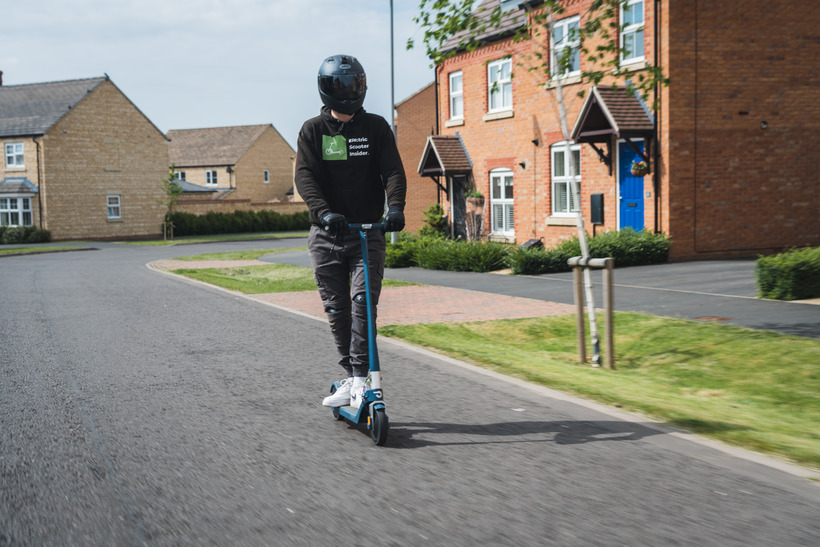
To allow for the comparison of multiple scooters so that I could identify the top performers, I expanded the field of candidates to include models that could reach speeds of between 17 and 23 mph.
Acceleration
While top speed is a vanity metric, acceleration is the truest measure of a scooter’s ability to get your adrenaline pumping.
Here, each scooter was subject to 6 acceleration tests. To do this, I ran 3x two-way 0-15 mph runs and averaged the data.
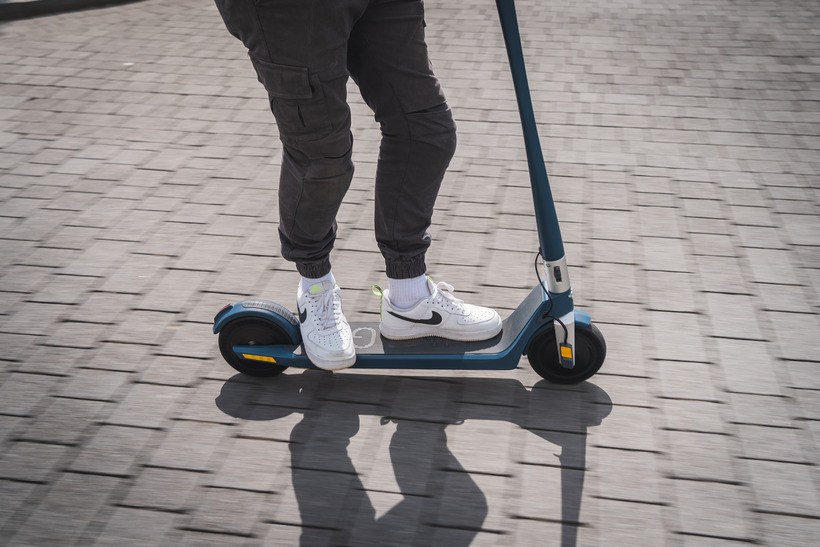
To ensure a level playing field, the performance settings of each scooter were dialed up to the max, their tires were pumped up to their recommended PSI, and their batteries were fully charged. Typically, I would also ensure that the scooters were in zero-start mode, but because some of them didn’t have this feature I chose to use the kick-off method instead.
Controllers
Controllers are responsible for the coordination of how battery power is delivered to the motors, as well as any other electrical components.
Similar to motors, the power of a controller is determined by its amps and voltage. Typically, higher amps and voltage results in greater torque, faster acceleration rates, and higher top speeds.
However, where I focused my attention was on the intensity at which the controllers pulled power. To assess this, I reported on each scooter’s throttle response to see if they were smooth or jerky.
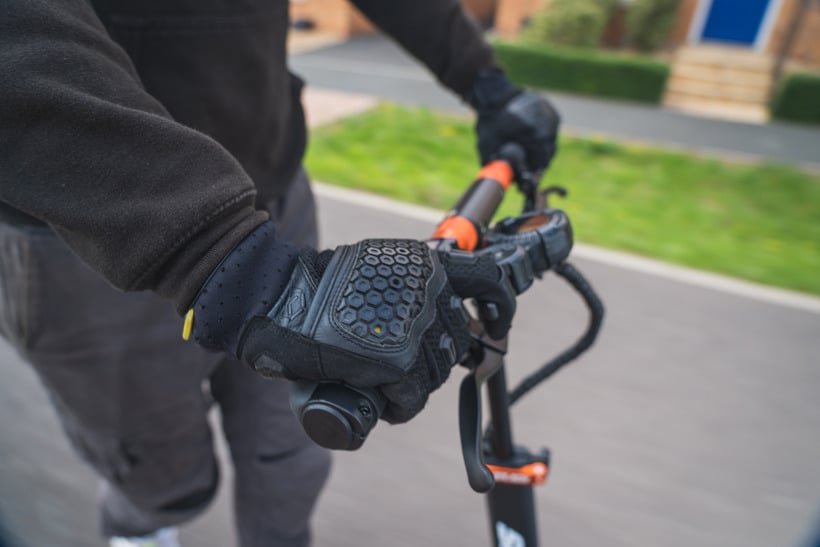
Motor Power
Motor power is measured in watts (W) and volts (V).
Watts indicate the amount of power that a motor can produce, while volts determine the intensity at which electricity is being pushed through a motor. The higher the watts, the greater the top speed, and the higher the volts, the greater the torque and acceleration.
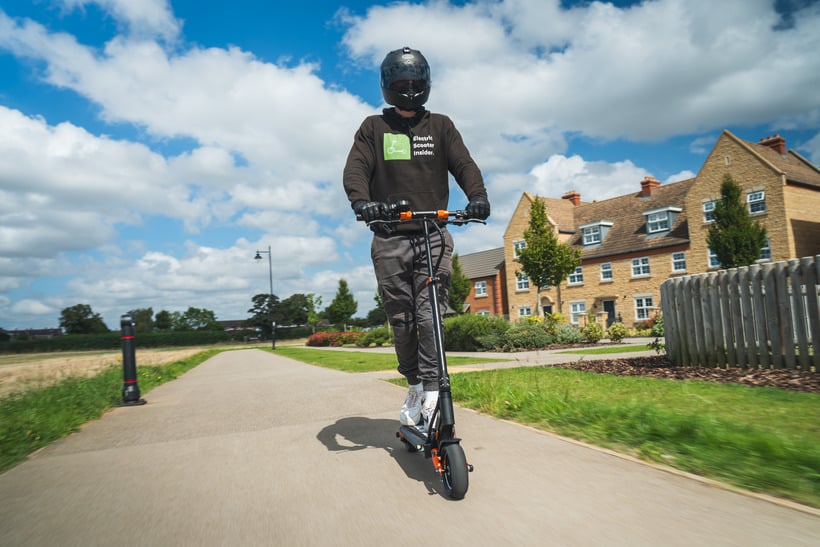
Alongside my top speed and acceleration tests, I gathered motor power insights to garner comparable data. Following my tests, it became clear that scooters able to reach speeds of up to 20 mph typically had motors with 350-500W and operated between 36 and 48V.
Nominal & Peak Power
While nominal power is a measure of the power that a motor can continuously produce without incurring damage, peak power is the instantaneous power that can be generated for short periods before overheating.
Here, I used my independently gathered data to compare power outputs relative to price (i.e. identifying the scooters with the most powerful outputs per dollar).
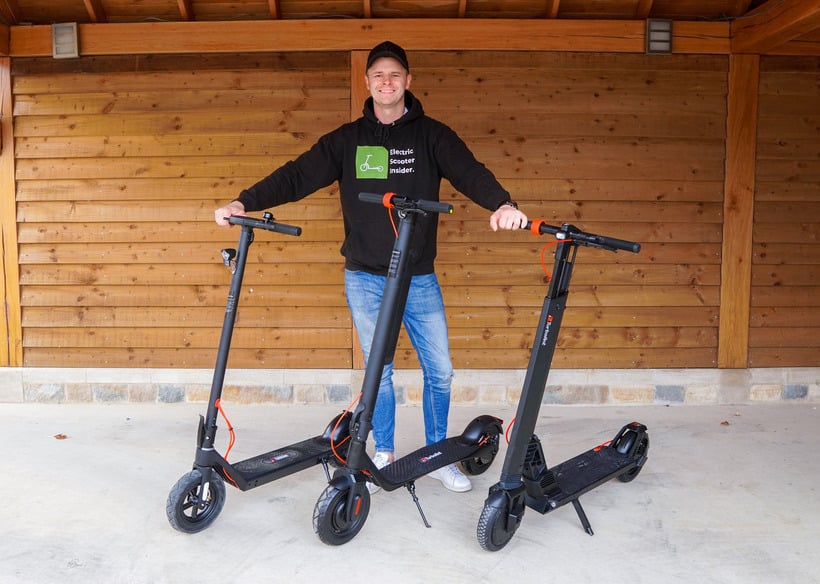
Handling
Riding at 20 mph requires good handling and this is determined by each scooter’s stability, control, and comfort.
To assess stability, I first reported on the weight distribution of each scooter. The top performers had well-balanced frames, meaning everything from the handlebars, stem, and chassis felt aligned.
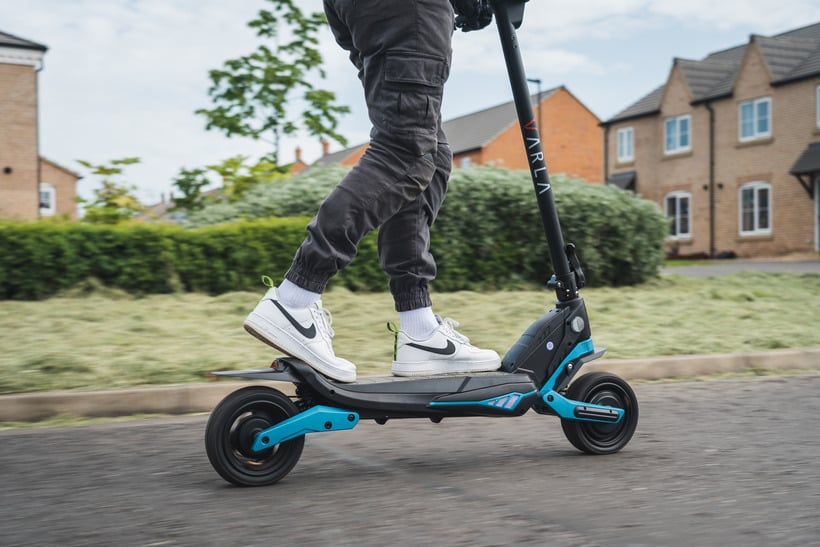
Taking this analysis one step further, I assessed rake angles (i.e. the angle at which each scooter’s steering column was positioned in relation to a vertical axis through its front axle). Here, I made sure to select the scooters with rake angles that hit the sweet spot between stability and nimbleness (this typically equated to around 11 degrees).
Next up was control. Aside from getting a feel for each scooter, I also measured their handlebar width, deck-to-handlebar height, and usable deck space. The wider the bars, the greater the control. The higher the deck-to-handlebar height, the better your posture. And, the bigger the deck space, the more room there was to find a natural riding stance.
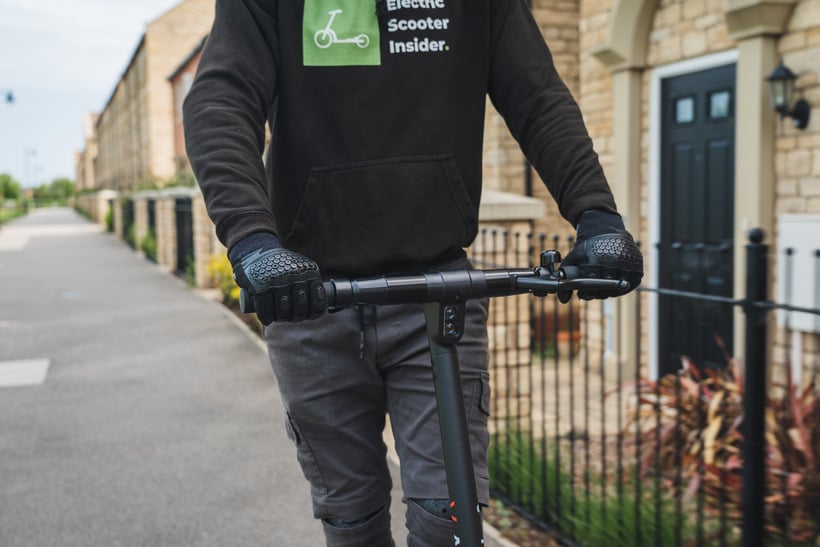
The last area of assessment was comfort and so, I reported on each scooter’s ability to soak up shocks. For scooters that had suspension systems, I tested their rebound and compression rates, the balance of shock absorption (i.e. across the front and rear of the scooter), the amount of travel that the springs, shocks, and swingarms provided, and whether there was any bottoming out. For scooters without suspension, I reported on the shock-absorbing profile of their tires.
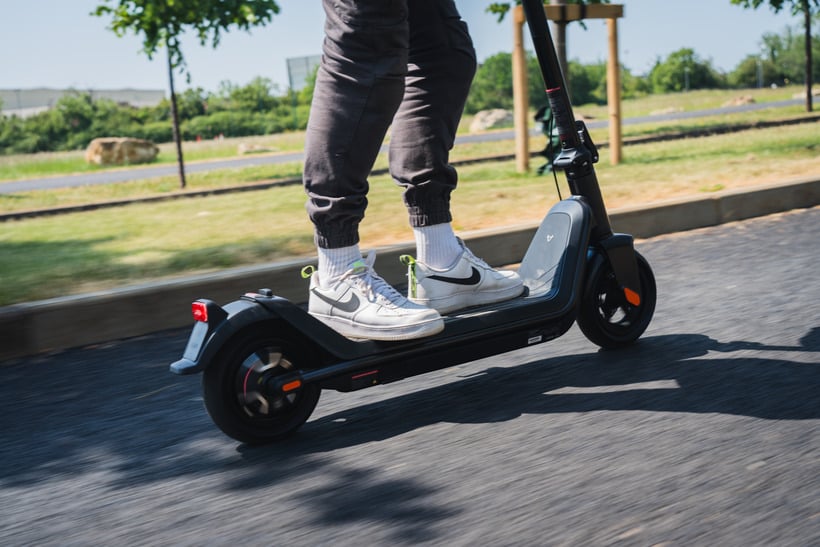
Braking
Although 20 mph is slow in the grand scheme of electric scooter performance, strong brakes are still a must.
To test each scooter, I measured the distance that it took for them to stop from 15 mph. I conducted 5 braking tests per scooter and averaged the data.
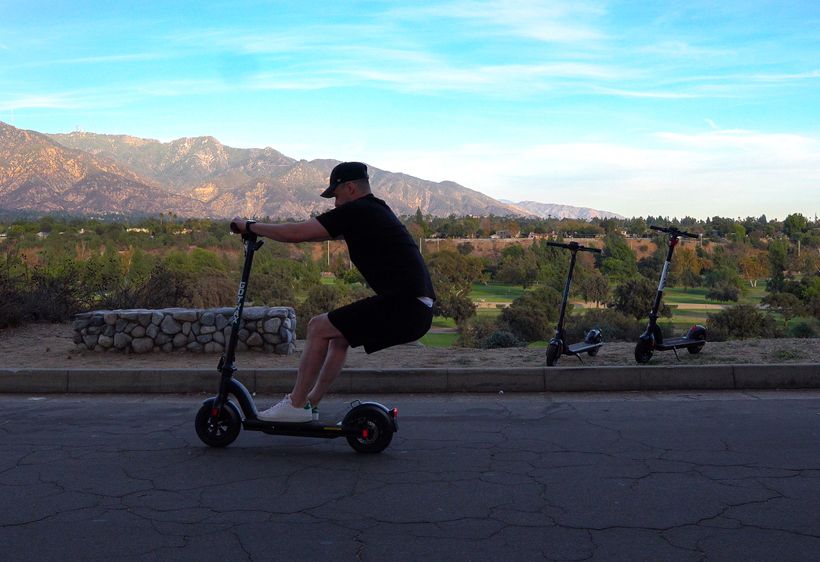
If electronic or regenerative braking systems were present then I dialed their strength up to the max. I also assessed the position and responsiveness of the brake levers.
Results From My Performance Tests:
See how the electric scooters stack up against each other across the metrics of top speed, acceleration, maximum range, tested range, and braking.
Top Speed
Ordered from fastest to slowest – Learn about how I test top speed.
| Scooter | Price | Top Speed |
|---|---|---|
| Horizon |
$749
| 23 MPH |
| Apollo Air 2023 |
$849
| 21 MPH |
| NIU KQi3 Pro |
$559
| 20 MPH |
| Turboant X7 Max |
$429.98
| 20 MPH |
| Turboant V8 |
$569.98
| 20 MPH |
| GoTrax G4 |
$449
| 20 MPH |
Acceleration (0-15 MPH)
Ordered from fastest to slowest – Learn about how I test acceleration.
| Scooter | Price | 0-15 MPH (Seconds) |
|---|---|---|
| Horizon |
$749
| 4.7 s |
| Apollo Air 2023 |
$849
| 5.7 s |
| NIU KQi3 Pro |
$559
| 5.0 s |
| Turboant V8 |
$569.98
| 6.3 s |
| GoTrax G4 |
$449
| 6.3 s |
| Turboant X7 Max |
$429.98
| 6.9 s |
Maximum Range (Riding Slow)
Ordered from longest to shortest range.
| Scooter | Price | Max Range |
|---|---|---|
| Turboant V8 |
$569.98
| 50 miles |
| Apollo Air 2023 |
$849
| 34 miles |
| Turboant X7 Max |
$429.98
| 32 miles |
| NIU KQi3 Pro |
$559
| 31 miles |
| Horizon |
$749
| 30 miles |
| GoTrax G4 |
$449
| 25 miles |
Realistic Range (Riding Fast)
Ordered from longest to shortest range – Learn about how I test real-world range.
| Scooter | Price | Real Range |
|---|---|---|
| Turboant V8 |
$569.98
| 25 miles |
| Apollo Air 2023 |
$849
| 23 miles |
| Horizon |
$749
| 23 miles |
| NIU KQi3 Pro |
$559
| 22 miles |
| Turboant X7 Max |
$429.98
| 18 miles |
| GoTrax G4 |
$449
| 14 miles |
Braking (From 15 MPH)
Ordered from shortest to longest stopping distance – Learn about how I test braking performance.
| Scooter | Price | Braking From 15 MPH |
|---|---|---|
| NIU KQi3 Pro |
$559
| 2.2 meters |
| Turboant X7 Max |
$429.98
| 3.0 meters |
| Apollo Air 2023 |
$849
| 3.4 meters |
| Turboant V8 |
$569.98
| 4.7 meters |
| Horizon |
$749
| 5.0 meters |
| GoTrax G4 |
$449
| 6.0 meters |
Recent Updates
In the interest of delivering the most timely, relevant, and credible reviews/guides in the industry, I have detailed the recent updates and changes to my list of the best 20 mph electric scooters. Learn more about my editorial policy.
- November 23, 2023: I removed the Turboant M10 following its discontinuation and recategorized the winners of each price category. Here, the Turboant X7 Max, GoTrax G4, and Turboant V8 were placed in the Best Under $500, $600, and $700 categories, respectively. Following this, the NIU KQi3 Pro was added as the "Best Under $800", while the Horizon 13 replaced the GoTrax GMAX Ultra as the "Best Under $900", and the Apollo Air 2023 replaced the Apollo Air 2022 as the "Best Under $1,000". I also refreshed the text throughout, expanded the commentary about how the scooters were tested and selected, added performance reports, and made improvements to the design of the page.
- May 2, 2023: Confirmed my picks for relevancy and availability.
- March 1, 2023: Added a quick list module and comparison table, as well as commentary explaining how the scooters were tested and selected.
- January 22, 2023: Confirmed my picks for relevancy and availability.
- September 30, 2022: Refreshed the guide with 6 new top-performing scooters across 6 price categories.



